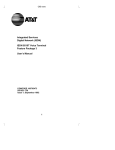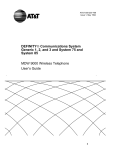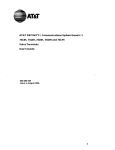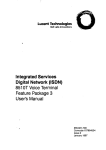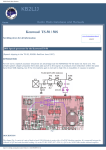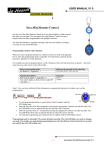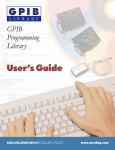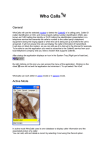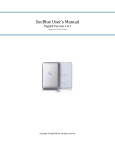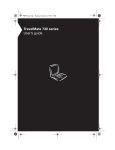Download 8510T - Help Desk Central
Transcript
Integrated Services
Digital Network (ISDN)
8510T Voice Terminal
Feature Package 3
User’s Manual
555-021-736
Comcode 107964504
Issue 2
December 1996
WARRANTY
All terms and conditions specified in the owner’s agreement with Lucent
Technologies apply.
NOTICE
While reasonable efforts were made to ensure that the information in this
document was complete and accurate at the time of printing, Lucent
Technologies can assume no responsibility for any errors. Changes or
corrections to the information contained in this document may be incorporated
into future issues.
TO ORDER COPIES OF THIS DOCUMENT
Write:
Lucent Technologies BCS Publications Center
P.O. Box 4100
Crawfordsville, IN 47933
Call:
Voice 1 800 457-1235
International Voice 317 361-5353
Fax:
Fax 1 800 457-1764
International Fax 317 361-5355
Order:
Document No. 555-021-736
Issue 2, December 1996
DISCLAIMER
Intellectual property related to this product (including trademarks) and registered
to AT&T Corporation has been transferred to Lucent Technologies Incorporated.
Any references within this text to American Telephone and Telegraph Corporation
or AT&T should be interpreted as references to Lucent Technologies
Incorporated. The exception is cross-references to books published prior to
December 31, 1996, which retain their original AT&T titles.
HERITAGE
Lucent Technologies — formed as a result of AT&T’s planned restructuring —
designs, builds, and delivers a wide range of public and private networks,
communication systems and software, consumer and business telephone
systems, and microelectronics components. The world-renowned Bell
Laboratories is the research and development arm for the company.
THE “CE” MARK
The “CE” mark affixed to this equipment means that it conforms to the European
Union Electromagnetic Compatibility Directive (89/336/EEC) and the Low Voltage
Directive (73/23/EEC).
HEARING AID COMPATIBILITY
These voice terminals are Hearing Aid Compatible (“HAC”). In addition, some
units have an “HAC” label on them.
TRADEMARKS
DEFINITY and 5ESS are registered trademarks of Lucent Technologies.
Prepared by
© 1996 Lucent Technologies
BCS Product Documentation Development
All Rights Reserved
Middletown, NJ 07748-9972
Printed in USA
INTERFERENCE WARNING INFORMATION
If the apparatus code on the bottom of your voice terminal is marked with
the suffix “(RS)” (for example, 8510TND03A(RS)-003), then it complies
with electromagnetic interference criteria specified by the FCC as suitable
for residential (or business) installation. As such, the FCC requires us to
provide the following warning for Class B residential installations.
WARNING: This equipment has been tested and found to comply with the
limits for a Class B digital device, pursuant to Part 15 of the FCC Rules.
These limits are designed to provide reasonable protection against
harmful interference in a residential installation. This equipment
generates, uses, and can radiate radio frequency energy and, if not
installed and used in accordance with the instructions, may cause harmful
interference to radio and television communications. However, there is no
guarantee that interference will not occur in a particular installation. If this
equipment does cause harmful interference to radio or television
reception, which can be determined by turning the equipment off and on,
the user is encouraged to try to correct the interference by one or more of
the following measures:
■
Reorient or relocate the receiving antennae.
■
Increase the separation between the equipment and receiver.
■
Connect the equipment into an outlet on a circuit different from
that to which the receiver is connected.
■
Consult the dealer or an experienced radio/tv technician for
help.
If the apparatus code on the bottom of your voice terminal is NOT marked
with the suffix “(RS)”, then it complies with criteria specified by the FCC as
suitable for a Class A business installation only. In this case, the FCC
requires us to provide the following warning for Class A business
installations.
WARNING: This equipment has been tested and found to comply with the
limits for a Class A digital device, pursuant to Part 15 of the FCC Rules.
These limits are designed to provide reasonable protection aginst harmful
interference when the equipment is operated in a commercial
environment. This equipment generates, uses, and can radiate radio
frequency energy and, if not installed and used in accordance with the
instruction manual, may cause harmful interference to radio and television
communications. Operation of this equipment in a residential area is likely
to cause harmful interference in which case the user will be required to
correct the interference at his own expense.
IMPORTANT SAFETY INSTRUCTIONS
Only the most careful attention has been devoted to quality standards in
the manufacture of your new telephone. Safety is a major factor in the
design of every set. But, safety is YOUR responsibility too.
Please read carefully the helpful tips listed below and on the next page.
These suggestions will enable you to take fullest advantage of your new
voice terminal. Then, retain these tips for later use.
When using your telephone equipment, the following safety precautions
should always be followed to reduce the risk of fire, electric shock, and
injury to persons.
d Read and understand all instructions.
d Follow all warnings and instructions marked on the telephone.
d This telephone can be hazardous if immersed in water. To avoid the
possibility of electrical shock, do not use the telephone while you are
in the bathtub or shower, or when you are wet. If you accidentally
drop the telephone into water, do not retrieve the equipment until you
have first unplugged the line cord from the modular wall jack. Do not
reconnect the telephone until it has dried thoroughly.
d Avoid using the telephone (other than the cordless type) during
electrical storms in your immediate area. There is a remote risk of
electric shock from lightning. Urgent calls should be brief. Even
though protective measures may have been installed to limit
electrical surges from entering your home or business, absolute
protection from lightning is impossible.
d If you suspect a natural gas leak in the vicinity of the telephone,
report it immediately, but use a telephone away from the area in
question. The telephone’s electrical contacts could generate a tiny
spark. While unlikely, it is possible that this spark could ignite heavy
concentrations of gas.
d Never push objects of any kind into the telephone through housing
slots since they may touch hazardous voltage points or short out
parts that could result in a risk of electric shock. Never spill liquid of
any kind on the telephone. If liquid is spilled, however, dry
immediately, and refer any service problems to qualified service
personnel.
d To reduce the risk of electric shock, do not disassemble the
telephone. There are no user serviceable parts inside. Opening or
removing covers may expose you to hazardous voltages. Incorrect
reassembly can cause electric shock when the telephone is
subsequently used.
d Slots and openings in the housing must not be blocked or covered.
The openings should never be blocked by placing the telephone on a
sofa, rug or other similar surface. This product should never be
placed near or over a radiator or heat register. This product should
not be placed in a built-in installation unless proper ventilation is
provided.
d The telephone should be operated only from the type of power
source indicated on the marking label. If you are not sure of the type
of power supply being used, contact a qualified service person.
d Do not allow anything to rest on the power cord. Do not locate this
product where the cord will be abused by persons walking on it.
d Do not overload the AC wall outlets and extension cords as this can
result in risk of fire or electric shock.
d Before cleaning, disconnect all cords from the telephone. Do not
use liquid cleaners or aerosol cleaners. Use a damp cloth for
cleaning.
d Disconnect the cords on the telephone and refer servicing to qualified
service personnel when these conditions exist:
When the power supply cord or plug is damaged or frayed.
If liquid has been spilled into the product.
If the product has been exposed to rain or water.
If the telephone does not operate normally by following the
operating instructions. Do not attempt to adjust any other
controls since doing so may result in damage and will require
extensive work by a qualified technician to restore the product to
normal operation.
If the product has been dropped or the housing has been
damaged.
If the product exhibits a distinct change in performance.
SAVE THESE INSTRUCTIONS
!
When you see this warning symbol on the product, refer to the
instructions booklet packed with the product for information before
proceeding.
Contents
Introduction……………………………………………………………1
Organization of this Manual ………………………………………1
Conventions Used in this Manual …………………………………2
A Note on the Term, System Manager …………………………2
Your ISDN 8510T Voice Terminal …………………………………3
Feature Descriptions ………………………………………………7
Voice Features………………………………………………………7
Features Accessed with the Display and Softkeys………………8
Voice Features ………………………………………………………10
Answering and Placing a Call ……………………………………10
Conference…………………………………………………………11
Drop…………………………………………………………………11
Hold …………………………………………………………………12
Message Retrieval ………………………………………………12
Mute ………………………………………………………………13
Redial (Last Number Dialed) ……………………………………13
Speakerphone and Speaker ……………………………………14
Transfer ……………………………………………………………16
Features Accessed with the Display and Softkeys……………17
Entering and Exiting Softkey Mode
(Using the Menu and the Exit Buttons) …………………………18
The Voice Terminal Self-Test Feature …………………………19
Using the Next, the Prev, and the Dir Buttons …………………19
Responding to Quit and Done……………………………………19
A Softkey Display Screen Flowchart ……………………………20
Setting the Clock …………………………………………………22
Setting the Speakerphone ………………………………………24
Adding, Editing, and Deleting
a Number and Name in the Directory……………………………26
Viewing a Directory Entry (and Placing a Call)…………………33
Using the Dir Button to Place a Call ……………………………35
Using the Call Log…………………………………………………36
Locking and Unlocking the Directory,
Call Log, and All Softkeys ………………………………………51
Changing or Removing Your Password…………………………55
Self-Test ……………………………………………………………57
Choosing the Contrast Level for the Display……………………59
Selecting a Personalized Ring……………………………………61
Setting the Rate at Which You View the Display Messages …63
Turning on or off Softkey Information Tones……………………65
Setting the Number of Names on the Directory Page …………67
Tones and Their Meanings ………………………………………68
Voice Terminal Tones ……………………………………………68
Labeling and Installing the Designation Card
and the Telephone Number Card ………………………………69
Installation……………………………………………………………71
Contents of the 8510T Package …………………………………71
Desktop Installation ………………………………………………71
Attaching Adjunct Equipment ……………………………………73
Technical Description ……………………………………………74
Introduction
The Lucent Technologies 8510T voice terminal can be added to your
Integrated Services Digital Network (ISDN) communications system. In
order to provide you with excellent quality and reliability, Lucent
Technologies has designed this new voice terminal with the latest
advances in telecommunications technology.
The 8510T voice terminal offers 10 call appearances, Mute, Redial,
Conference, Drop, Transfer, and Hold buttons, a Speakerphone which
can also be optioned as a listen-only Speaker, a Volume control, and an
Adjunct jack for adjunct equipment, all that you will need for easy and
efficient call-handling. Four softkeys (the keys with arrows printed on
them) and 4 display control buttons located below a 2-line by
24-character liquid crystal display can be used to access such features
as a personal Directory, a Call Log which lists the most recent incoming
and outgoing calls, the Self-Test feature, and a personalized ringing
pattern for the voice terminal.
The following features have been included for the
hearing and visually impaired person:
Two small bars have been placed on the 5 dial
pad key;
The rate at which the display messages appear
on your screen can be set at Slow, Medium, or
Fast;
Confirmation and error tones;
Compatibility with inductively coupled hearing
aids.
ORGANIZATION OF THIS MANUAL
This manual is arranged into the following sections:
d Your ISDN 8510T Voice Terminal — shows the top and bottom
views of the 8510T and explains its features.
d Feature Descriptions — lists the voice features and the features
that can be accessed with the softkeys, tells what each feature does,
and suggests how you might use it.
d Voice Features — gives step-by-step procedures on using voice
features.
d Features Accessed with the Display and Softkeys — describes
the softkeys and how to use them to access features such as setting
up and using a personal Directory of frequently called numbers and
viewing a Call Log of incoming and outgoing calls.
1
d Tones and Their Meaning — lists and describes the various voice
terminal tones.
d Labeling and Installing the Designation Card — explains how to
remove and label the designation card.
d Installation — gives brief step-by-step procedures for connecting
your voice terminal to the system, desktop installation such as
connecting the handset and the line cord, and, if appropriate,
attaching adjunct equipment.
d Technical Description — provides information on the technical
aspects of the 8510T voice terminal.
CONVENTIONS USED IN THIS MANUAL
bbbbbbb
A rectangular box containing a feature name, such as cbRedial
bbbbbc ,
represents any button having a feature assigned to it, with a
corresponding feature name label.
A 2-line screen, such as
bbbbbbbbbbbbbbbbbbbbbbbb
MENU
> cc
c
Directory CallLog Option c
cb
c bbbbbbbbbbbbbbbbbbbbbbb
bbbbbb
Menu display
represents the display that is shown when you press the cbbbbbbc
control button. The second line of the display lists the features you can
access by using the 4 softkeys (the buttons labeled with arrows).
A NOTE ON THE TERM, ``SYSTEM MANAGER´´
In this manual it is often suggested that you refer to your System
Manager for more information. The System Manager may also be called
the System Administrator or, possibly, the Telecommunications
Manager. For handy reference, use the space below to write your
System Manager’s name, room number, and extension.
Name ________________________________________
Room _______________________ Extension ________
2
Your ISDN 8510T Voice Terminal
Before you begin using your ISDN 8510T voice terminal, familiarize
yourself with the voice terminal features, lights, jacks, and other
components that are available to you. To help you do this, Figures 1
and 2 show you the top and bottom views of the 8510T voice terminal.
b bbbbbbbbbbbbbbbbbbbbbbbbbbbbbbbbbbbbbbbbb
c
c
c
Telephone
Handset
Display
c number
c
c card
c
ISDN 8510T
c
c
c
c
4 Softkeys
c
c
4 Display
c
control buttons
c
c
10 Call
c
appearance/
c
feature buttons
c
c
and designation
c
card
c
c
Message light
c
c
c
c
Dial pad
c
c
c
*
c
c
c
c
c
c Volume control button
c
c
Redial button
Mute button
c
Exit button
Speaker button
c
c
Drop button
Conference button
c
Hold button
Transfer button
c
c
bc bbbbbbbbbbbbbbbbbbbbbbbbbbbbbbbbbbbbbbbbbc
M enu
D ir
Prev
a
f
b
g
c
h
d
i
e
j
ABC
Volum e
M ute
Speaker
N ext
D EF
1
2
3
GH I
JKL
M NO
Redial
4
5
6
PQ RS
TU V
W XYZ
8
9
Exit
Conf
D rop
Transfer
H old
7
O per
0
FIGURE 1 8510T Voice Terminal (Top View)
3
#
The 8510T voice terminal components pictured in Figure 1, the top view,
are described below and on the next page. For your convenience, they
are listed alphabetically.
These 10 buttons are devoted either to
handling incoming and outgoing calls (call appearances) and are labeled
with the exchange (numbers) and extension number or they can be used
as feature buttons to access voice features such as Call Forward or
Send All Calls; these are labeled with the feature name. Each of these
10 call appearance/feature buttons has a red light, which indicates the
selected line and a green light which indicates the status of that line or
feature.
Call appearance/feature buttons
Conference button For setting up conference calls with an additional
party.
Designation card For noting the call appearance telephone number or
extension or feature that the button can access.
Dial pad The standard 12-button pad for dialing telephone numbers
and accessing features. The letters, "Q" and "Z," have been added
to the appropriate dial pad keys for entering directory names, and
the "5" button on your dial pad has raised bars for visually-impaired
users.
These 4 buttons are labeled Menu, Dir,
< Prev, and Next > .
bbbbbb
Menu button is used to access the main softkey menu.
d The cbbbbbbc
bbbb
Dir (Directory) button allows you to quickly access Directory
d The cbbbbc
entries in order to place a call.
bbbbbbb
bbbbbbb
> buttons can be used to help you go back
< Prev and cbNext
d The cbbbbbbbc
bbbbbc
and forth through menu options, to search for an entry in your
Directory, and to view entries in your Call Log.
Display control buttons
Drop button For disconnecting from a call or dropping the last party
added to a conference call.
For exiting a display feature and returning to normal callhandling mode.
Exit button
Handset For placing and answering calls (often people call it the
receiver).
Hold button A red button, for putting a voice call on hold.
4
A red light which goes on steadily when a message has
been left for you. See your System Manager for instructions regarding
your local message retrieval procedures.
Message light
For turning off (and then back on again) the microphone of
the handset or the speakerphone so the other person on the call cannot
hear you.
Mute button
Redial button For automatically redialing the last number that you dialed
from the dial pad.
Softkeys The 4 buttons located below the display and labeled with
arrows (
), correspond to words on the display screen. Softkeys
are used along with display control keys to access or create a personal
Directory of frequently-called numbers, a Call Log of the most recent
incoming and outgoing calls, and such features as selecting a
personalized ringing pattern, doing a self-test of your voice terminal, and
setting the speakerphone and the clock.
Speaker button For turning on and off the speakerphone or the
listen-only speaker.
Telephone number card For noting the area code and telephone number
of your voice terminal.
Transfer button For transferring a call to another voice terminal.
When on a call, used to increase or decrease the
receive volume of the handset or speakerphone (if on a call). When you
are not on a call, the Volume control button is used to increase or
decrease the volume of the ringer and the tones.
Volume control button
5
b bbbbbbbbbbbbbbbbbbbbbbbbbbbbbbbbbbbbbbbbb
c
c
c
c
c
c
c
c
Kickstand
c
c
c
c
Routing
c channel
c
Handset
c Line jack
c
jack
c Adjunct
c
jack
c
c
c
c
c
c
!
c
c
c
c
FCC Warning Bar Code
c
label
label
c
bc bbbbbbbbbbbbbbbbbbbbbbbbbbbbbbbbbbbbbbbbbc
FIGURE 2 8510T Voice Terminal (Bottom View With Kickstand)
The various components which appear on the bottom of the 8510T voice
terminal are shown in Figure 2 and listed and explained below.
Adjunct jack Used for connecting an external speakerphone, a headset
adaptor, or other adjunct equipment. The jack is labeled "ADJUNCT."
WARNING: Do not insert the handset cord into the "ADJUNCT" jack. It
will cause equipment damage.
Handset jack Used for connecting the handset cord to your voice
terminal. The jack is labeled
.
Kickstand Can be lifted from the desktop stand or can be left level with
the bottom of the voice terminal. Check which kickstand adjustment
allows you the best viewing angle of the display.
Line jack Used for connecting the line cord to your voice terminal. The
jack is labeled "LINE."
Routing channel Thread the line cord (and adjunct cord, if applicable)
through the routing channel. See the section titled Installation.
6
Feature Descriptions
Here are brief descriptions of the voice features and the features
accessed with the softkeys, including what each one does and how you
might want to use it.
VOICE FEATURES
Conference Allows you to add an additional party to a call so that you
can conduct a conversation with more than one party. Use to set up
time-saving conferences, or to spontaneously include a party important
to a discussion.
Drop Disconnects you from a call without requiring you to hang up the
handset or press the switchhook. Can also be used with the Conference
feature to disconnect the last party added. Use whenever you are using
the handset and want to continue using it for another action after ending
a call.
Hold Temporarily disconnects you from a call, holding it until you can
return to it. While a call is on hold, you can place another call, activate
another feature, answer a waiting call, or leave your voice terminal to
perform another task. Use when you have a call that you don’t wish to
drop, but for which you have to interrupt briefly to do something else.
Your Message light goes on to let you know that a
caller has left a message. Follow your System’s message retrieval
procedures to get your message.
Message Retrieval
Mute Turns off the microphone associated with the handset or the
speakerphone, whichever is currently active. Use when you want to
confer with someone in the room with you, but you do not want the other
party on the call to hear your conversation. (You are still able to hear the
person on the call.)
Redial (Last Number Dialed) Automatically redials the last number you
dialed manually from the dial pad, either an extension or an outside
number. Use to save time in redialing a busy or unanswered number.
Speakerphone Your voice terminal has either the Speaker (listen-only)
or the Speakerphone (listen and talk) function or it may have neither.
Check with the System Manager to see how your voice terminal is set.
The Speaker feature allows you to place calls
or access other voice
bbbbbbbb
Speaker .) However, in
features without lifting the handset. (Press cbbbbbbbbc
order to speak to the other party, you must use the handset (the speaker
must be off). Use with feature activities that require listening only, such
as on-hook dialing or monitoring calls on hold.
7
The Speakerphone feature allows you to place and answer calls or
access
bbbbbbbbother voice features without lifting the handset. (Press
Speaker .) You may use the softkeys on the voice terminal to set or
cbbbbbbbbc
reset the speakerphone. When you set the built-in speakerphone, it
performs a test of the surrounding environment and adjusts itself for
optimal performance. Use the built-in speakerphone any time you prefer
hands-free communications, both speaking and listening, or for group
conference situations.
Transfer Transfers a call from your voice terminal to another extension.
Use when your caller needs to speak further with someone else.
FEATURES ACCESSED WITH THE DISPLAY AND SOFTKEYS
The following features can be accessed using the 4 softkeys located
below the display.
Call Log The Call Log is initially set to list the 10 most recent incoming
unanswered calls only. An option is provided so that you may also
choose to access the most 10 recent answered calls, and the 10 most
recent outgoing calls placed from your voice terminal. Use to check on
calls that you missed (the unanswered calls) and to remind you of those
calls that you answered or placed most recently.
Clock For setting the date and time on your voice terminal display.
Contrast Change the contrast level of your display so that the letters or
numbers are darker or lighter against the background of the screen.
Directory Used to create and edit a personal directory of up to 30
extensions
bbbb or outside numbers and the names of the associated party.
Dir to quickly dial a call. Use as a handy place to store numbers
Use cbbbbc
you frequently call.
bbbb
Dir followed by a softkey button
Dir Button When you press cbbbbc
associated with that Directory entry, a call is immediately placed to a
telephone number. The phone number appears on the display screen as
it dials.
Exits a display feature and returns the voice terminal display
to normal call-handling mode.
Exit button
Lock Allows you to lock your Directory so that no one can make
unauthorized changes in it; lock your Call Log so that no one else can
view your Call Log entries; lock all of the softkeys so that no one can
view or change any of the features accessed by the softkeys.
8
Allows you to view either
4 names or 3 names + Quit on the second line of an individual Directory
page. If you choose to have 4 names on the Directory screen at one
time, you can leave the Directory
bbbbb or cancel calling a name in your
Exit (rather than using Quit).
Directory only by pressing cbbbbbc
Number of Names (on a Directory Page)
Personalized Ring Allows you to select your own personalized ringing
pattern from among 8 available patterns. Use to distinguish your voice
terminal’s ring from that of other nearby voice terminals.
Allows you
to set the length of time the display message remains on the screen.
There are 3 rates: Slow, Medium, and Fast.
Screen Timing (Rate at which the Display Message is Shown)
Self-Test Performs a diagnostic test of your voice terminal including the
lights, ringer, dial pad keys, and display.
NOTE: When you perform a self-test of the voice terminal, it clears the
contents of the Call Log and the last number dialed from Redial, and
returns the volume control to the default setting.
Set Speakerphone When you set the built-in speakerphone, it performs
a test of the surrounding environment and adjusts itself for optimal
performance.
Tones A confirmation tone (sequential low and high tones) is provided
to let you know a selection has been accepted; an error tone (one beep)
alerts you that you made a mistake in your softkey entries. You may
choose to turn these softkey information tones on or off.
9
Voice Features
The procedures which follow give short, step-by-step instructions for
using each feature. For your convenience, the features are listed
alphabetically. Unless otherwise noted, the calling procedure assumes
that the handset is off-hook.
aaaaaaaaaaaaaaaaaaaaaaaaaaaaaaaaaaaaaaaaaaaaaaaaaaaaaaaaaaaaaaaaaaaa
ANSWERING AND PLACING A CALL
aaaaaaaaaaaaaaaaaaaaaaaaaaaaaaaaaaaaaaaaaaaaaaaaaaaaaaaaaaaaaaaaaaaa
To answer a call
1
Lift the handset.
d The green light (below the red light) goes on steadily at the
selected call appearance button.
NOTE: If you are not connected immediately, press the call
appearance button next to the flashing green light.
To place a call
1
Lift the handset.
d The green (below the red light) goes on steadily at the selected
call appearance button.
2
Listen for the dial tone and dial the number you want to call.
To end (or drop) a call
1
bbbbbb
Hang up the handset or press the cbDrop
bbbbc button
bbbbbb
NOTE: If you use the cbDrop
bbbbc button, you will hear a dial tone and your
voice terminal is ready for another call.
To adjust the receive volume of the handset, the speakerphone, or
the listen-only speaker
1
While on a call,
to raise the volume, press the right half of the Volume control button
labeled
;
to lower the volume, press the left half of the Volume control button
labeled
.
10
aaaaaaaaaaaaaaaaaaaaaaaaaaaaaaaaaaaaaaaaaaaaaaaaaaaaaaaaaaaaaaaaaaaa
CONFERENCE
aaaaaaaaaaaaaaaaaaaaaaaaaaaaaaaaaaaaaaaaaaaaaaaaaaaaaaaaaaaaaaaaaaaa
To add another party to a call
bbbbbb
1 While on a call, press cbConf
bbbbc to add the next party.
d The current call is placed on hold.
d The red Conference light flutters.
NOTE: If an idle call appearance button is not automatically
selected, press one yourself.
2
3
Listen for the dial tone, and dial the number of the next party.
b bbbb
Press cbConf
bbbbc when the next party answers.
d The red Conference light goes off.
d All parties are now connected.
To drop a party from a conference call
bbbbbb
1 Press cbDrop
bbbbc .
d The last party you added is dropped.
aaaaaaaaaaaaaaaaaaaaaaaaaaaaaaaaaaaaaaaaaaaaaaaaaaaaaaaaaaaaaaaaaaaa
DROP
aaaaaaaaaaaaaaaaaaaaaaaaaaaaaaaaaaaaaaaaaaaaaaaaaaaaaaaaaaaaaaaaaaaa
To disconnect from a call and obtain dial tone without hanging up
bbbbbb
1 Press cbDrop
bbbbc .
d Listen for dial tone.
bbbbbb
NOTE: Pressing cbDrop
bbbbc will also disconnect the last party added to a
conference call. See the procedures for the Conference feature in
this section.
11
aaaaaaaaaaaaaaaaaaaaaaaaaaaaaaaaaaaaaaaaaaaaaaaaaaaaaaaaaaaaaaaaaaaa
HOLD
aaaaaaaaaaaaaaaaaaaaaaaaaaaaaaaaaaaaaaaaaaaaaaaaaaaaaaaaaaaaaaaaaaaa
To put a call on hold while you answer another call
NOTE: The green light is flashing beside the call appearance button of
the incoming call.
b bbbb
1 Press cbHold
bbbbc .
d The red light goes off, and the green light flutters (next to the call
appearance button of the held call).
2
Press the call appearance button of the second call.
d The red light goes on, and the green light goes on steadily.
d You are connected to the second call.
NOTE: If you put a conference call on hold, the other parties remain
connected.
To return to the held call
1
Press the call appearance button next to the held call.
d The red light goes on, and the green light goes on steadily (next
to the call appearance button of the previously held call).
d You are connected to the held call.
aaaaaaaaaaaaaaaaaaaaaaaaaaaaaaaaaaaaaaaaaaaaaaaaaaaaaaaaaaaaaaaaaaaa
MESSAGE RETRIEVAL
aaaaaaaaaaaaaaaaaaaaaaaaaaaaaaaaaaaaaaaaaaaaaaaaaaaaaaaaaaaaaaaaaaaa
See your System Manager for instructions regarding the message
retrieval procedures for your system.
12
aaaaaaaaaaaaaaaaaaaaaaaaaaaaaaaaaaaaaaaaaaaaaaaaaaaaaaaaaaaaaaaaaaaa
MUTE
aaaaaaaaaaaaaaaaaaaaaaaaaaaaaaaaaaaaaaaaaaaaaaaaaaaaaaaaaaaaaaaaaaaa
To turn off the microphone associated with the handset or the
speakerphone so the other party cannot hear you
bbbbbb
Mute .
1 While on a call, press cbbbbbbc
d The red Mute light goes on.
d The other party cannot hear your conversation, but you can hear
the other party.
To turn on the microphone associated with the handset or
speakerphone again, so the other party can hear you again
bbbbbb
Mute again.
1 Press cbbbbbbc
d The red Mute light goes off.
d You can resume your conversation with the other party.
aaaaaaaaaaaaaaaaaaaaaaaaaaaaaaaaaaaaaaaaaaaaaaaaaaaaaaaaaaaaaaaaaaaa
REDIAL (LAST NUMBER DIALED)
aaaaaaaaaaaaaaaaaaaaaaaaaaaaaaaaaaaaaaaaaaaaaaaaaaaaaaaaaaaaaaaaaaaa
To automatically redial the last number you dialed manually (this
can be an extension, outside number, or trunk/feature code)
NOTE: The 8510T voice terminal redials numbers consisting of up to
37 digits.
1
2
3
Lift the handset.
bbbbbbb
Listen for the dial tone, and press cbRedial
bbbbbc .
d The last number you dialed (from the dial pad) is automatically
redialed.
Wait for the called party to answer.
13
aaaaaaaaaaaaaaaaaaaaaaaaaaaaaaaaaaaaaaaaaaaaaaaaaaaaaaaaaaaaaaaaaaaa
SPEAKERPHONE AND SPEAKER
aaaaaaaaaaaaaaaaaaaaaaaaaaaaaaaaaaaaaaaaaaaaaaaaaaaaaaaaaaaaaaaaaaaa
NOTE: Your voice terminal is set for the Speaker (listen-only) or for the
Speakerphone (listen and speak) function or for neither. Check with
your System Manager to see how your voice terminal is set.
Speaker
Use the following procedures if your voice terminal is set for the Speaker
(listen only) feature.
To place/answer a call without lifting the handset or to use the
speaker with any listening-only feature
bbbbbbbb
Speaker .
1 Press cbbbbbbbbc
bbbbbb
bbbbbbbb
Mute go
Speaker and the red light next to cb
d The red light next to cbbbbbbbbc
bbbbbc
on.
2
Place or answer the call or access a selected feature.
3
If you are placing a call, dial the telephone number.
4
Adjust speaker volume, if necessary.
5
d To raise the volume, press the right half of the Volume control
button labeled
;
to lower the volume, press the left half of the Volume control
button labeled
.
bbbbbbbb
Speaker to hang up.
Press cbbbbbbbbc
bbbbbb
bbbbbbbb
Mute go
Speaker and the red light next to cb
d The red light next to cbbbbbbbbc
bbbbbc
off.
To activate the speaker while using the handset
bbbbbbbb
Speaker .
1 Press cbbbbbbbbc
bbbbbb
bbbbbbbb
Mute
Speaker and the red light next to cb
d The red light next to cbbbbbbbbc
bbbbbc
go on.
d The speaker is active, and the handset is turned off.
2
Hang up handset.
NOTE: If you want to speak to the other party, you must pick up the
handset (which turns off the speaker).
14
Speakerphone
Use the following procedures if your voice terminal is set for the
Speakerphone (listen and speak) feature.
NOTE: If your voice terminal is set for the Speakerphone feature, you
can adjust the speakerphone to the surrounding room acoustics to
provide optimal performance. Use the directions in "Setting the
Speakerphone" in the section titled Features Accessed with the
Display and Softkeys.
To place/answer a call without lifting the handset or to use the
speakerphone with any voice feature
bbbbbbbb
Speaker .
1 Press cbbbbbbbbc
bbbbbbbb
Speaker goes on.
d The red light next to cbbbbbbbbc
2
Place or answer the call or access a selected feature.
3
If you are placing a call, dial the telephone number.
4
Adjust the speakerphone volume if necessary.
5
d To raise the volume, press the right half of the Volume control
button labeled
;
to lower the volume, press the left half of the Volume control
button labeled
.
bbbbbbbb
Speaker to hang up.
Press cbbbbbbbbc
bbbbbbbb
Speaker goes off.
d The red light next to cbbbbbbbbc
To prevent the other party from hearing you
NOTE: If the Speakerphone feature is not active, the Mute feature turns
off the microphone associated with the handset (not the speakerphone).
bbbbbb
Mute .
1 Press cbbbbbbc
2
d The red light goes on and the other party cannot hear you.
bbbbbb
Mute again to resume talking to other party.
Press cbbbbbbc
d The red light goes off and the other party can hear you again.
To change from speakerphone to handset
1
Lift handset and talk.
bbbbbbbb
Speaker goes off.
d The red light next to cbbbbbbbbc
15
Speakerphone (Continued)
To change from handset to speakerphone
bbbbbbbb
Speaker .
1 Press cbbbbbbbbc
bbbbbbbb
Speaker goes on.
d The red light next to cbbbbbbbbc
d The speaker is active, and the handset is turned off.
2
Hang up the handset.
aaaaaaaaaaaaaaaaaaaaaaaaaaaaaaaaaaaaaaaaaaaaaaaaaaaaaaaaaaaaaaaaaaaa
TRANSFER
aaaaaaaaaaaaaaaaaaaaaaaaaaaaaaaaaaaaaaaaaaaaaaaaaaaaaaaaaaaaaaaaaaaa
To send a call to another extension
bbbbbbbb
Transfer .
1 Press cbbbbbbbbc
d The present call is put on hold.
d The red Transfer light flutters.
2
Listen for dial tone.
3
Dial the number that the call is to be transferred to (third party).
d Remain on the line and announce the call when the third party
answers.
NOTE: If the number of the third party is busy or there is no answer,
4
press the call appearance button next to the fluttering green light to
disconnect the incomplete call and to return to the call on hold.
bbbbbbbb
Transfer again.
Press cbbbbbbbbc
d The party on hold is transferred to the third party.
d Your voice terminal is released from the call.
5
Hang up.
NOTE: To prevent a transfer call from disconnecting, complete the
transfer process before entering into another action, such as
answering another call.
16
Features Accessed with the Display and
Softkeys
The softkeys are the 4 keys labeled with arrows (
) located directly
below the display. Figure 3 shows the softkeys in relation to the display
above the softkeys and the display control buttons below them.
b bbbbbbbbbbbbbbbbbbbbbbbbbbbbbbbbbbbbbbbbb
c
cc
Display
c
c
c
c
c
ISDN 8510T
c
c
c
c
c
c
c
c
Softkeys
c
c
Display control buttons c
c
c
c
c
cbc bbbbbbbbbbbbbbbbbbbbbbbbbbbbbbbbbbbbbbbbbc
FIGURE 3 The 8510T Voice Terminal Display, Softkeys, and Display Control Buttons
You can use the softkeys and display control buttons to access the
following features:
d Setting the clock;
d Setting the speakerphone;
d Adding, editing, and deleting the numbers and associated names in
the voice terminal Directory;
d Viewing a Directory entry and then placing a call to the number
currently shown on the display screen;
bbbb
Dir button to quickly place a call to a number located in
d Using the cbbbbc
your Directory;
d Using the Call Log to view incoming and/or outgoing calls;
d Locking and unlocking the Directory, Call Log, and all softkey
functions;
d Changing or removing your password;
17
d Initiating a self-test of the voice terminal’s lights, ringer, buttons, and
dial pad keys;
d Selecting the contrast level for the display;
d Selecting a personalized ringing pattern;
d Setting the rate at which the display messages are shown on the
screen;
d Adding confirmation or error tones to display messages;
d Setting the number of names on a Directory page.
ENTERING AND EXITING SOFTKEY MODE
(USING THE MENU AND THE EXIT BUTTONS)
bbbbbb
Menu button. The
You can begin to use the softkeys by pressing the cbbbbbbc
main Menu screen that you see looks like this:
bbbbbbbbbbbbbbbbbbbbbbbb
MENU
> cc
c
Directory CallLog Option c
cb
c bbbbbbbbbbbbbbbbbbbbbbb
Notice that the first line of the menu is fully capitalized, so that you know
the feature that you are responding to. The second line of the voice
terminal display shows the menu choices that you can select. To access
any of the choices, you must press the softkey below that menu choice.
For example, by using the menu above, you can enter your Directory by
pressing the leftmost softkey, the one under Directory. To access the
voice terminal Call Log, you would press the softkey below CallLog. To
view other softkey options, press the softkey below Option.
bbbbbb
Menu while the Main Menu is on your display
NOTE: If you press cbbbbbbc
screen, you will exit Softkey mode.
bbbbbb
Menu will abandon any action
If you are at any other screen, pressing cbbbbbbc
and return you to the Main Menu.
There are also "timed" informative screens which appear for only a few
seconds. You do not need to respond to these screens. (If you press
any of the softkeys during one of these timed messages, the display
advances to the next message.)
bbbbb
Exit at any time to exit softkey mode, abandon any softkey
Press cbbbbbc
functions in progress, and return to normal call-handling mode.
18
THE VOICE TERMINAL SELF-TEST FEATURE
bbbbbbb
Next > while the Main Menu shown above is on the display
If you press cbbbbbbbc
screen, the following menu screen appears:
bbbbbbbbbbbbbbbbbbbbbbbb
MENU
c <
cc
Test
cc bbbbbbbbbbbbbbbbbbbbbbb
b
c
If you press the softkey below Test, you can perform a test of your voice
terminal’s lights, ringer, display, and dial pad keys. For directions on
using the Self-Test feature, see "Self-Test" in this section.
NOTE: Performing a self-test of the voice terminal clears the contents of
the Call Log and the last number dialed from Redial, and the volume
setting is returned to the default.
USING THE NEXT, THE PREV, AND THE DIR BUTTONS
bbbbbbb
Next >
If there is a ">" at the top right of the screen, you can press the cbbbbbbbc
button to see the next set of menubbbbbbb
selections. If there is a "<" at the top
< Prev button to move back a screen
left of the screen, you can press cbbbbbbbc
on that level.
bbbb
Dir button to enter your Directory in order to quickly place a
Use the cbbbbc
call.
RESPONDING TO ´QUIT´ AND ´DONE´
When you see Quit on the second line of the display, it means that
you have the option of abandoning the action you have begun.
Press the softkey below Quit if you do not want to respond to the
options on the screen.
When you see Done on the second line of the display, it means that
you have already entered information or accessed a feature.
Pressing the softkey below Done will confirm your action and allow
you to move on to the next screen.
NOTE: In most of the display messages shown in this section, Done
appears in the right lower corner, rather thanbbbbb
Quit. Remember that if
Exit to abandon.
Quit is not available, you can always press cbbbbbc
19
A SOFTKEY DISPLAY SCREEN FLOWCHART
Review the display screen flowchart in Figure 4 before you begin using
the softkey features. A more detailed flowchart appears in the ISDN
8510T Voice Terminal Quick Reference Guide.
20
FIGURE 4 A Flowchart of the Softkey Display Screens
21
Name
<
Name
Name
<
>
Name
Name
>
Spkr
Option
Set
Clock
Lock
Directory,
Call Log,
or Softkeys
Lock
OPTIONS
Clock
Delete
<
Test
Edit
Done
MENU
>
Done
Self-Test
ADD/DEL DIRECTORY
Quit
>
Set
Speakerphone
Add
PRESS TO VIEW
Quit
Done
Call Log
CallLog
MENU
Add/Del
DIRECTORY
View
Name
CALL
Call
Directory
Set
Display
Contrast
Cntrast
<
Select
Ring
Ring
Set Timed
Screen
Duration
Screen
OPTIONS
Done
>
Done
Set Number
of Names on
Directory Page
Set Call Log:
Off
Unanswered-only
All
Set
Information
Tones
Names
OPTIONS
Tones CallLog
<
b bbbbbbbbbbbbbbbbbbbbbbbbbbbbbbbbbbbbbbbbb
c
cc
c
c
c
c
c
c
c
c
c
c
c
c
c
c
c
c
c
c
c
c
c
c
c
c
c
c
c
c
c
c
c
c
c
c
c
c
c
c
c
c
c
c
c
c
c
c
c
c
c
c
c
c
c
c
c
c
cbc bbbbbbbbbbbbbbbbbbbbbbbbbbbbbbbbbbbbbbbbbc
aaaaaaaaaaaaaaaaaaaaaaaaaaaaaaaaaaaaaaaaaaaaaaaaaaaaaaaaaaaaaaaaaaaa
SETTING THE CLOCK
aaaaaaaaaaaaaaaaaaaaaaaaaaaaaaaaaaaaaaaaaaaaaaaaaaaaaaaaaaaaaaaaaaaa
When your voice terminal is first installed, when it is unplugged and then
plugged in again, or after a power outage, this display is shown:
bbbbbbbbbbbbbbbbbbbbbbbb
c PRESS Menu THEN Option cc
TO SET THE CLOCK.
cb
c bbbbbbbbbbbbbbbbbbbbbbb
c
To set the clock
1
bbbbbb
Menu .
Press cbbbbbbc
d The display shows:
bbbbbbbbbbbbbbbbbbbbbbbb
MENU
> cc
c
Directory CallLog Option c
cb
c bbbbbbbbbbbbbbbbbbbbbbb
2
Press
(the softkey) below Option.
d The display shows:
bbbbbbbbbbbbbbbbbbbbbbbb
OPTIONS
> cc
c
Spkr Clock Lock Done c
cb
c bbbbbbbbbbbbbbbbbbbbbbb
22
3
Press
(the softkey) below Clock.
d The display shows the date and time, such as:
bbbbbbbbbbbbbbbbbbbbbbbb
c Sep 24, 1992 10:00 AM cc
+
Quit c
cb
c bbbbbbbbbbbbbbbbbbbbbbb
The display format for the clock is:
MMM DD, YYYY HH:MM AM or PM
in which MMM = month abbreviation, such as "Oct"
DD = day of the month such as "02" or "24"
YYYY = year such as "1992"
HH:MM = hour and minutes such as "10:45"
AM or PM = morning or afternoon
4
Do the following to change the date and/or time:
Use the softkey below + to go forward a month (such as from
"Sep" to "Oct"), to go forward a day (such as from "24" to "25"), a
year, an hour or a minute, or to switch between "AM" and "PM."
Use the softkey below - to go back a month (such as from "Sep"
to "Aug"), to go back a day (such as from "24" to "23"), a year, an
hour, or a minute, or to switch between "AM" and "PM."
NOTE: You can also use the dial pad to change the display
clock. For example, when the month is flashing on the screen,
you can press the 8 key to change the month to August, or, when
the date is flashing, enter "25" from the dial pad to select "25" as
the date. Use "A" for "AM" or "P" for "PM."
The display field, which you are currently viewing, such as "Sep,"
flashes. To go on to the next field,
such as from "Sep" (the
bbbbbbb
> . The Quit menu choice
month) to "24" (the day), press cbNext
bbbbbc
at the lower right corner changes to Done.
5
When the correct date appears on the display , press the softkey
below Done.
d The display confirms your changes.
6
Once the clock has been set, you can now set the speakerphone.
Go on to the next procedure, "Setting the Speakerphone."
23
aaaaaaaaaaaaaaaaaaaaaaaaaaaaaaaaaaaaaaaaaaaaaaaaaaaaaaaaaaaaaaaaaaaa
SETTING THE SPEAKERPHONE
aaaaaaaaaaaaaaaaaaaaaaaaaaaaaaaaaaaaaaaaaaaaaaaaaaaaaaaaaaaaaaaaaaaa
When you set the speakerphone on your voice terminal, you hear a set
of tones as the speakerphone performs an acoustic test of the
environment. When the tones stop, your speakerphone has finished
adjusting itself for optimal performance and is ready for use. You must
set the speakerphone when you initially set up your voice terminal, and
reset it when you move the voice terminal to a different location (even if
it’s in the same room), or after a power outage.
After you have set the clock, the following display appears (if the
speakerphone needs to be set).
bbbbbbbbbbbbbbbbbbbbbbbb
c READY TO SET THE SPKR cc
Begin
Cancel c
cb
c bbbbbbbbbbbbbbbbbbbbbbb
Follow these procedures to set the speakerphone.
1
Press the softkey below Begin to set the speakerphone.
(Press the softkey below Cancel if you do not want to set or reset the
speakerphone at this time.)
d If you press the softkey below Begin, the display shows the
following timed screen:
bbbbbbbbbbbbbbbbbbbbbbbb
c OPTIMIZING PERFORMANCE cc
OF THE SPEAKERPHONE.
cb
c
c bbbbbbbbbbbbbbbbbbbbbbb
d You will hear a set of rising tones as the speakerphone adjusts
itself to the surrounding acoustical environment. These tones are
automatic. No user response is required.
24
The following procedure is an alternate way of using the softkeys to
set the speakerphone.
1
2
bbbbbb
Menu .
Press cbbbbbbc
Press the softkey below Option.
d The display shows:
bbbbbbbbbbbbbbbbbbbbbbbb
OPTIONS
> cc
c
Spkr Clock Lock Done c
cc bbbbbbbbbbbbbbbbbbbbbbb
b
3
Press the softkey below Spkr.
d The display shows:
bbbbbbbbbbbbbbbbbbbbbbbb
c OPTIMIZING PERFORMANCE cc
OF THE SPEAKERPHONE.
cb
c bbbbbbbbbbbbbbbbbbbbbbb
c
d You hear a set of rising tones as the speakerphone adjusts itself
to the surrounding acoustical environment. These tones are
automatic. No user response is required.
25
aaaaaaaaaaaaaaaaaaaaaaaaaaaaaaaaaaaaaaaaaaaaaaaaaaaaaaaaaaaaaaaaaaaa
ADDING, EDITING, AND DELETING A NUMBER AND NAME IN THE
DIRECTORY
aaaaaaaaaaaaaaaaaaaaaaaaaaaaaaaaaaaaaaaaaaaaaaaaaaaaaaaaaaaaaaaaaaaa
The 8510T voice terminal supports up to 30 Directory entries. The
telephone numbers entered in the Directory can be up to 24 digits, and
associated names can be up to 5 characters in length. Directory entries
can be changed by deleting or editing.
When you enter names into your Directory, the entries are automatically
alphabetized for you.
NOTE: If there are frequently used names that you want to place at the
front of your Directory, place a # or * as the first character in the name
such as "#KimB" or "*Dan." These names will then appear before the
"A’s" in your Directory. (Names beginning with # appear first in the
Directory, followed by names beginning with *, and then names
beginning with a number, 0 through 9, and then the alphabet.)
Adding Numbers and Names Into the Directory
To enter/add a number and name into the Directory
2
bbbbbb
Menu .
Press cbbbbbbc
Press the softkey below Directory.
3
Press the softkey below Add/Del.
1
NOTE: If the directory is locked, you must enter your 3-digit
password in order to modify your Directory. See the information in
"Locking and Unlocking the Directory, Call Log, and All Softkeys"
later in this section.
d The display shows:
bbbbbbbbbbbbbbbbbbbbbbbb
ADD/DEL DIRECTORY
c
cc
Add Delete Edit Done c
cc bbbbbbbbbbbbbbbbbbbbbbb
b
4
Press the softkey below Add.
26
d The display shows:
bbbbbbbbbbbbbbbbbbbbbbbb
c ENTER PHONE #:_
cc
Pause
Quit c
cb
c bbbbbbbbbbbbbbbbbbbbbbb
5
Enter the telephone number you want to be added to the Directory.
(You can enter up to 24 digits. A pause counts as 1 digit.)
NOTE: To place a 1.5 second pause between an access code, such
as "9," and the telephone number, press the softkey below Pause. A
pause will be inserted into the Directory entry, and a comma will
appear on the display.
d After you have entered at least one digit, you will see the
following display:
bbbbbbbbbbbbbbbbbbbbbbbb
cc
c ENTER PHONE #:9_
Pause Backspace
Done c
cb
c bbbbbbbbbbbbbbbbbbbbbbb
IMPORTANT: Hyphens, dashes and/or spaces are NOT necessary
between digits. (For example, in the Directory, the number,
555-1234, is entered as "5551234," without the intervening hyphen.)
NOTE: After you have entered 10 digits, including any pauses, the
words, "Enter Phone #:" begin to move off the display screen one
letter at a time in order to accommodate the remainder of the
telephone number.
When you are finished entering the phone number, press the softkey
below Done .
d The display shows:
bbbbbbbbbbbbbbbbbbbbbbbb
c ENTER 5-CHAR NAME:_
cc
Quit c
cb
c bbbbbbbbbbbbbbbbbbbbbbb
27
6
Use the dial pad keys to enter the name of the person whose number
you have just added to the Directory. Pressing the softkey below
Quit now will abandon the procedure. The number you entered will
not be saved.
IMPORTANT: You may need to press the dial pad key more than
once to enter the correct character. For example, press the GHI (or
4) key once to enter a "G"; press the 4 key twice to enter an "H";
press the key a third time to enter an "I." If you press the dial pad
key a fourth time, a "4" appears on the screen. If you press the key
again, the screen will again print a "G."
You can also use a # or a * at the beginning of or within the name.
bbbbbbb
Next > to
Once the letter on the screen is correct, you must press cbbbbbbbc
enter the next letter.
d After you have entered at least one character, the following
display appears:
bbbbbbbbbbbbbbbbbbbbbbbb
c ENTER 5-CHAR NAME:A
cc
Case DeleteChar Done c
cb
c bbbbbbbbbbbbbbbbbbbbbbb
NOTE: As you enter each letter of the name, that letter flashes on
the screen until you move on to the next letter.
When a letter is flashing, use Case to switch between UPPER
CASE and lower case letters. Of course, you may have a
combination of both in your 5-character name (such as Sandy or
HarvW).
When a letter is flashing, use DeleteChar to erase that letter.
bbbbb
Use cbNext
bbbbc to advance to the next letter.
bbbbbbbbbbbbbbbbbbbbbbbb
c ENTER 5-CHAR NAME:A_
cc
Backspace
Done c
cb
c bbbbbbbbbbbbbbbbbbbbbbb
When Backspace appears on the second line of the display, you
can use this feature to go back 1 space and erase the previous
letter.
28
7
When you are finished entering the name, press the softkey below
Done.
d The display confirms your entry.
Editing Entries in the Directory
To edit a Directory entry
2
bbbbbb
Menu .
Press cbbbbbbc
Press the softkey below Directory.
3
Press the softkey below Add/Del.
1
NOTE: If the directory is locked, you must enter your 3-digit
password in order to modify your Directory. (See the information in
"Locking and Unlocking the Directory, Call Log, and All Softkeys"
later in this section.)
d The display shows:
bbbbbbbbbbbbbbbbbbbbbbbb
ADD/DEL DIRECTORY
c
cc
Add Delete Edit Done c
cb
c bbbbbbbbbbbbbbbbbbbbbbb
4
Press the softkey below Edit in order to edit a Directory entry.
d The display shows:
bbbbbbbbbbbbbbbbbbbbbbbb
c < SELECT TO EDIT > cc
HarvW Kathy Sandy Quit c
b
cc bbbbbbbbbbbbbbbbbbbbbbb
NOTE: Once again, remember that the names in the Directory
are arranged alphabetically.
5
Do the following:
bbbbbbb
Next > to page forward through the names in the
Press cbbbbbbbc
Directory.
29
bbbbbbb
< Prev to page backwards through the names in the
Press cbbbbbbbc
Directory.
6
Press the softkey below the name of the entry you want to edit.
d The display shows:
bbbbbbbbbbbbbbbbbbbbbbbb
c EDIT 5-CHAR NAME: Harv_ cc
Backspace
Done c
cb
c bbbbbbbbbbbbbbbbbbbbbbb
7
If the phone number is correct and you don’t wish to edit it at this
time, press the softkey below Done.
If you want to edit the name, do the following:
You may need to press the dial pad key more than once to enter
the correct character. For example, press the GHI (or 4) key
once to enter a "G"; press the 4 key twice to enter an "H"; press
the key a third time to enter an "I." If you press the dial pad key
a fourth time, a "4" appears on the screen. If you press the key
again, the screen will again print a "G."
bbbbbbb
> to advance to the next letter.
Use cbNext
bbbbbc
Press the softkey below Backspace to move back and erase the
previous letter.
bbbbbbb
< Prev to move back a letter without erasing it.
Press cbbbbbbbc
8
When you have completed entering the 5-character name, press the
softkey below Done.
d The display then shows:
bbbbbbbbbbbbbbbbbbbbbbbb
cc
c EDIT PHONE #:5551234_
Pause Backspace
Done c
cb
c bbbbbbbbbbbbbbbbbbbbbbb
9
If the phone number is correct and you don’t wish to edit it at this
time, press the softkey below Done. (You are done editing a
directory entry.)
If you want to edit the phone number, do the following:
Press the softkey below Pause to insert a 1.5-second pause in
the telephone number. Each pause in the number is represented
on the screen by a comma.
30
To move back and erase a number, press the softkey below
Backspace.
When you have completed editing the telephone number, press
the softkey below Done.
d The display confirms your choice.
Deleting an Entry from the Directory
To delete an entry from the Directory
2
bbbbbb
Menu .
Press cbbbbbbc
Press the softkey below Directory.
3
Press the softkey below Add/Del to add or delete a Directory entry.
1
NOTE: If the directory is locked, you must enter your 3-digit
password in order to modify your Directory. (See the information in
"Locking and Unlocking the Directory, Call Log, and All Softkeys"
later in this section.)
d The display shows:
bbbbbbbbbbbbbbbbbbbbbbbb
ADD/DEL DIRECTORY
cc
c
Add Delete Edit Done c
cb
c bbbbbbbbbbbbbbbbbbbbbbb
4
Press the softkey below Delete.
d The display shows:
bbbbbbbbbbbbbbbbbbbbbbbb
c < SELECT TO DELETE > cc
HarvW Kathy Sandy Quit c
cb
c bbbbbbbbbbbbbbbbbbbbbbb
31
5
Do the following:
bbbbbbb
Next > to page forward through the names in the
Press cbbbbbbbc
Directory.
bbbbbbb
< Prev to page backwards through the names in the
Press cbbbbbbbc
Directory.
6
Press the softkey below the name of the entry you want to delete.
d The display shows:
bbbbbbbbbbbbbbbbbbbbbbbb
c 5551234
cc
HarvW
Delete
Quit
cc bbbbbbbbbbbbbbbbbbbbbbbc
b
7
Press the softkey below Delete if you want to delete this entry.
d The display confirms your choice.
32
aaaaaaaaaaaaaaaaaaaaaaaaaaaaaaaaaaaaaaaaaaaaaaaaaaaaaaaaaaaaaaaaaaaa
VIEWING A DIRECTORY ENTRY (AND PLACING A CALL)
aaaaaaaaaaaaaaaaaaaaaaaaaaaaaaaaaaaaaaaaaaaaaaaaaaaaaaaaaaaaaaaaaaaa
Directory entries can be viewed and changed, or you can exit the
directory and have the voice terminal automatically dial the telephone
number you are presently viewing.
To view a Directory entry (and, if desired, call that number)
bbbb
Dir button to call a number in your
NOTE: You can also use the cbbbbc
directory. To do this, use the procedures in "Using the Dir Button to
Place a Call."
1
2
bbbbbb
Menu .
Press cbbbbbbc
Press the softkey below Directory.
d The display shows:
bbbbbbbbbbbbbbbbbbbbbbbb
DIRECTORY
c
cc
Call
View
Add/Del
Done
cc bbbbbbbbbbbbbbbbbbbbbbbc
b
3
Press the softkey below View.
d The display shows:
bbbbbbbbbbbbbbbbbbbbbbbb
> cc
c < PRESS TO VIEW
HarvW Kathy Sandy Quit c
cb
c bbbbbbbbbbbbbbbbbbbbbbb
4
Do the following:
bbbbbbb
Next > to page forward through the names in the
Press cbbbbbbbc
Directory.
bbbbbbb
< Prev to page backwards through the names in the
Press cbbbbbbbc
Directory.
33
5
Press the softkey below the Directory entry of the name you want to
view.
d The display shows:
bbbbbbbbbbbbbbbbbbbbbbbb
c 5551234
cc
HarvW Call Edit/Del Done c
cb
c bbbbbbbbbbbbbbbbbbbbbbb
NOTE: The name of the person associated with this telephone
number, such as HarvW, is shown in the lower left corner.
6
Do one of the following:
To call this number, press the softkey below Call.
d The voice terminal exits softkey mode and dials the telephone
number you are currently viewing on the screen.
If you want to edit or delete the Directory entry, press the softkey
below Edit/Del.
d The display shows:
bbbbbbbbbbbbbbbbbbbbbbbb
cc
c EDIT/DELETE HarvW
Edit Delete
Quit c
cb
c bbbbbbbbbbbbbbbbbbbbbbb
If you want to edit the Directory entry, press the softkey under
Edit. If you want to delete the Directory entry, press the
softkey below Delete. (If you need help in editing or deleting
the Directory entry, return to the directions in "Adding,
Editing, and Deleting a Number and Name in the Directory").
7
If you have completed viewing the telephone number, press the
softkey below Done.
34
aaaaaaaaaaaaaaaaaaaaaaaaaaaaaaaaaaaaaaaaaaaaaaaaaaaaaaaaaaaaaaaaaaaa
USING THE DIR BUTTON TO PLACE A CALL
aaaaaaaaaaaaaaaaaaaaaaaaaaaaaaaaaaaaaaaaaaaaaaaaaaaaaaaaaaaaaaaaaaaa
bbbb
Dir button to place a call to a number entered in
You can also use the cbbbbc
your Directory.
IMPORTANT: When you press the softkey under the name in the
Directory you wish to call, the call is placed immediately. The menu
does not ask you to respond to a screen before the call is placed.
To use the Dir button to call a person whose number appears in
your Directory
1
bbbb
Dir to enter your Directory.
Press cbbbbc
d The display shows:
bbbbbbbbbbbbbbbbbbbbbbbb
CALL
> cc
c <
HarvW Kathy Sandy Quit c
cb
c bbbbbbbbbbbbbbbbbbbbbbb
NOTE: The word "CALL" flashes to remind you that if you press a
softkey below a name, it will automatically call that entry.
2
Do the following:
bbbbbbb
> to page forward through the names in the
Press cbNext
bbbbbc
Directory.
bbbbbbb
< Prev to page backwards through the names in the
Press cbbbbbbbc
Directory.
3
When the name of the person whose number you want to call
appears on the second line of the screen, press the softkey below
that name.
d The voice terminal exits softkey mode and dials the telephone
number you have selected immediately.
35
aaaaaaaaaaaaaaaaaaaaaaaaaaaaaaaaaaaaaaaaaaaaaaaaaaaaaaaaaaaaaaaaaaaa
USING THE CALL LOG
aaaaaaaaaaaaaaaaaaaaaaaaaaaaaaaaaaaaaaaaaaaaaaaaaaaaaaaaaaaaaaaaaaaa
The voice terminal Call Log stores the 10 most recent unanswered
incoming calls, the 10 most recent answered incoming calls, and the
10 most recent calls that were placed at the voice terminal.
NOTE: If multiple calls from the same telephone number are received,
only the most recent call from that number appears in the Call Log.
When an eleventh call comes in or is placed, it is added to the top of the
Call Log in the appropriate category; the call listed at the bottom of the
list in that category is deleted from the list.
When your voice terminal arrives and is initially set up, it will have an
Unanswered Call Log. If you want to readjust your own Call Log, see the
procedures in the sub-section titled "Setting the Call Log." You may
designate whether you want to:
d Place only incoming unanswered calls into your Call Log;
d Turn off the Call Log;
d Place all calls, incoming and outgoing, into your Call Log.
NOTE: Incoming Call Log will reflect information provided by the network
your voice terminal is connected to. If no information appears in your
Call Log, see your System Manager.
Viewing Unanswered Incoming Calls in the Call Log
(When the Call Log is set to Unanswered Calls Only)
To view the 10 most recent unanswered calls (with Call Log set to
"Unanswered Only")
1
2
bbbbbb
Menu .
Press cbbbbbbc
Press the softkey below CallLog.
NOTE: If the Call Log is locked, you will need to enter your 3-digit
password before you can use the Call Log. (See the information in
"Locking and Unlocking the Directory, Call Log, and All Softkeys"
later in this section.)
36
d The display shows:
bbbbbbbbbbbbbbbbbbbbbbbb
c UNANSWERED CALL LOG
cc
New
Old
Done c
cb
c bbbbbbbbbbbbbbbbbbbbbbb
NOTE: The words, "New" or "Old" appear on the second line only
if you have new or old calls in your voice terminal’s Call Log.
3
Press the softkey below New or below Old according to the
unanswered calls you want to view at this time.
d The display shows:
bbbbbbbbbbbbbbbbbbbbbbbb
K.Smith > cc
c 555-1235
Time Delete
More c
cc bbbbbbbbbbbbbbbbbbbbbbb
b
NOTE: If the number and the name of the caller cannot be
identified, you will see the message, "Phone#/Name Unavailable"
on your display screen. (The name is present only if it’s an
internal call.)
4
If you want to see the time at which this call rang at your voice
terminal, press the softkey below Time.
5
If you want to remove this call from your Unanswered Call Log, press
the softkey below Delete.
6
If you want to see information on the next or bbbbbbb
previous call
in the Call
bbbbbbb
< Prev .
Next > or cbbbbbbbc
Log, press the softkey below More or press cbbbbbbbc
d The display shows you the number and name of the next or
previous unanswered call in the Call Log.
d The display tells you when you have finished viewing all the new
unanswered calls in the Call Log.
7
When you are finished viewing each unanswered call in the Call Log,
press the softkey below More until you reach the end of that list.
Then press the softkey below Done.
NOTE: After you have viewed new calls in the Call Log, they become old
calls. The Call Log will continue to hold the 10 most recent unanswered
calls.
37
Setting the Call Log
To turn on or to turn off, or to set the Call Log
1
2
3
bbbbbb
Menu .
Press cbbbbbbc
Press the softkey below Option.
bbbbbbb
> twice to view the third Option screen.
Press cbNext
bbbbbc
d The display shows the third option screen:
bbbbbbbbbbbbbbbbbbbbbbbb
OPTIONS
c <
cc
Tones CallLog Names Done c
cb
c bbbbbbbbbbbbbbbbbbbbbbb
4
Press the softkey below CallLog.
NOTE: If the Call Log is locked, you will need to enter your 3-digit
password before you can use the Call Log. (See the information in
"Locking and Unlocking the Directory, Call Log, and All Softkeys"
later in this section.)
d The display shows:
bbbbbbbbbbbbbbbbbbbbbbbb
CALL LOG OPTIONS
c
cc
Set-up Indicator Done c
cb
c bbbbbbbbbbbbbbbbbbbbbbb
5
To set up your Call Log (turn Call Log off, logs only unanswered
calls, or logs all calls), press the softkey below Set-up.
d The display shows the current status of the Call Log:
bbbbbbbbbbbbbbbbbbbbbbbb
c CALL LOG:UNANSWERED ONLY cc
Off Unansw All Done c
cb
c bbbbbbbbbbbbbbbbbbbbbbb
38
6
Do one of the following:
If you do not want your voice terminal to collect Call Log
information, press the softkey below Off.
If you want to have only unanswered calls entered into the Call
Log, press the softkey below Unansw.
If you want both unanswered and answered incoming calls and
all outgoing calls to be entered into your Call Log, press the
softkey below All.
d The display shows you the Call Log setting you have selected.
7
If the correct Call Log setting appears on your screen, press the
softkey below Done.
d The display confirms your choice.
d If the Call Log is turned off, the display asks you to confirm your
choice to clear and turn off the Call Log.
If you press the softkey below Yes, your Call Log is cleared and
then turned off, and the word "CallLog" will not appear on the
Main Menu.
Returning Calls to Callers Listed in Your Incoming Call Log
NOTE: You can use this feature only if your 8510 voice terminal has
Feature Package 3.6 firmware.
To be able to call back people whose names and numbers appear in
your incoming Call Log
1
2
3
bbbbbb
Menu .
Press cbbbbbbc
Press the softkey below Option.
bbbbbbb
> twice to view the third Option screen.
Press cbNext
bbbbbc
d The display shows the third option screen:
bbbbbbbbbbbbbbbbbbbbbbbb
OPTIONS
c <
cc
Tones CallLog Names Done c
cb
c bbbbbbbbbbbbbbbbbbbbbbb
39
4
Press the softkey below CallLog.
NOTE: If the Call Log is locked, you will need to enter your 3-digit
password before you can use the Call Log. (See the information in
"Locking and Unlocking the Directory, Call Log, and All Softkeys"
later in this section.)
d The display shows:
bbbbbbbbbbbbbbbbbbbbbbbb
CALL LOG OPTIONS
c
cc
Set-up Indicator Done c
cb
c bbbbbbbbbbbbbbbbbbbbbbb
5
bbbbbbb
> .
Press cbNext
bbbbbc
d The display shows:
bbbbbbbbbbbbbbbbbbbbbbbb
c < CALL LOG OPTIONS
cc
CallBack AutoAdd Done c
cb
c bbbbbbbbbbbbbbbbbbbbbbb
6
If you want to be able to call back callers in your incoming Call Log,
press the softkey below CallBack.
d The display shows the current setting for the CallBack feature
and allows you to change it:
bbbbbbbbbbbbbbbbbbbbbbbb
c CALL FROM INCOMING: No cc
Yes
No Explain Done c
cb
c bbbbbbbbbbbbbbbbbbbbbbb
7
If the CallBack feature is set to No, you can change the setting to
Yes by pressing the softkey below Yes.
NOTE: By setting the CallBack feature option to Yes, you can call
back callers in your incoming Call Log. This setting will be active until
you change the CallBack setting to No.
If you press the softkey below Explain, you can read more
information on the CallBack feature.
40
8
When the display shows the CallBack setting you prefer (Yes or No),
press the softkey below Done.
d If you activate the CallBack feature, the display message asks
you for your area code:
bbbbbbbbbbbbbbbbbbbbbbbb
ENTER AREACODE:_
c
cc
Pause Backspace Done c
cb
c bbbbbbbbbbbbbbbbbbbbbbb
or, if the voice terminal has already determined the area code
from past calls which you have placed, the display message asks
you to confirm your area code:
bbbbbbbbbbbbbbbbbbbbbbbb
c IS YOUR AREACODE 607 ? cc
Yes
No
cb
c bbbbbbbbbbbbbbbbbbbbbbb
c
9
Enter your area code and then press the softkey below Done
or press the softkey below Yes to verify your area code.
d The display confirms that you will now be able to return calls to
numbers in your incoming Call Log.
Automatically Adding Names and Numbers from Incoming Calls to
Your Directory
NOTE: You can use this feature only if your 8510 voice terminal is
equipped with Feature Package 3.6 (or later) firmware.
To automatically add incoming callers to your Directory
1
2
3
bbbbbb
Menu .
Press cbbbbbbc
Press the softkey below Option.
bbbbbbb
> twice to view the third Option screen.
Press cbNext
bbbbbc
41
d The display shows the third option screen:
bbbbbbbbbbbbbbbbbbbbbbbb
OPTIONS
c <
cc
Tones CallLog Names Done c
cb
c bbbbbbbbbbbbbbbbbbbbbbb
4
Press the softkey below CallLog.
NOTE: If the Call Log is locked, you will need to enter your 3-digit
password before you can use the Call Log. (See the information in
"Locking and Unlocking the Directory, Call Log, and All Softkeys"
later in this section.)
d The display shows:
bbbbbbbbbbbbbbbbbbbbbbbb
CALL LOG OPTIONS
c
cc
Set-up Indicator Done c
cb
c bbbbbbbbbbbbbbbbbbbbbbb
5
bbbbbbb
> .
Press cbNext
bbbbbc
d The display shows:
bbbbbbbbbbbbbbbbbbbbbbbb
c < CALL LOG OPTIONS
cc
CallBack AutoAdd Done c
cb
c bbbbbbbbbbbbbbbbbbbbbbb
6
Press the softkey below AutoAdd.
d The display shows:
bbbbbbbbbbbbbbbbbbbbbbbb
c SAVE INCOMING TO DIR? No cc
Yes
No Explain Done c
cb
c bbbbbbbbbbbbbbbbbbbbbbb
7
If you want to automatically add the names and numbers of incoming
calls to your Directory, press the softkey below Yes.
42
NOTE: If you select the Yes option, the names and numbers of
incoming callers will automatically be added to your Directory until
you change the AutoAdd setting to No.
8
When the display shows the AutoAdd setting you prefer (Yes or No),
press the softkey below Done.
d If you activate the AutoAdd feature, the display message asks
you for your area code:
bbbbbbbbbbbbbbbbbbbbbbbb
c ENTER AREACODE:_
cc
Pause
Backspace
Done
cc bbbbbbbbbbbbbbbbbbbbbbbc
b
or, if the voice terminal has already determined the area code
from past calls which you have placed, the display message asks
you to confirm your area code:
bbbbbbbbbbbbbbbbbbbbbbbb
c IS YOUR AREACODE 607 ? cc
Yes
No
cb
c bbbbbbbbbbbbbbbbbbbbbbb
c
9
Enter your area code and then press the softkey below Done
or press the softkey below Yes to verify your area code.
d The display confirms that incoming calls will be added to your
Directory.
43
Seeing Indication of New Unanswered Incoming Call(s)
Under the Date and Time on Your Display Screen
You can set your display so that you receive an indication when a new
unanswered incoming call is placed into your Call Log.
bbbbbbbbbbbbbbbbbbbbbbbb
c Sep 24, 1992 10:00 AM cc
(TWO NEW CALLS LOGGED.) c
cb
c bbbbbbbbbbbbbbbbbbbbbbb
To set your display so that you receive indication of new
unanswered incoming calls on the second line of the display
1
2
3
bbbbbb
Menu .
Press cbbbbbbc
Press the softkey below Option.
bbbbbbb
> twice to view the third Option screen.
Press cbNext
bbbbbc
d The display shows the third option screen:
bbbbbbbbbbbbbbbbbbbbbbbb
OPTIONS
c <
cc
Tones CallLog Names Done c
cb
c bbbbbbbbbbbbbbbbbbbbbbb
4
Press the softkey below CallLog.
NOTE: If the Call Log is locked, you will need to enter your 3-digit
password before you can use the Call Log. (See the information in
"Locking and Unlocking the Directory, Call Log, and All Softkeys"
later in this section.)
d The display shows:
bbbbbbbbbbbbbbbbbbbbbbbb
CALL LOG OPTIONS
cc
c
Set-up Indicator Done c
b
cc bbbbbbbbbbbbbbbbbbbbbbb
44
5
Press the softkey below Indicator.
d The display shows:
bbbbbbbbbbbbbbbbbbbbbbbb
c SHOW NEW CALL INDICATOR? cc
Yes
No
Explain c
cb
c bbbbbbbbbbbbbbbbbbbbbbb
6
Press the softkey below Yes or No.
NOTE: If you press the softkey below Explain, you can read more
information on the indicator feature.
d If you press No, the display returns you to the original "Call Log
Options" screen; if you press Yes, the display confirms that you
will receive indication when a new unanswered incoming call
arrives.
45
Viewing Unanswered Incoming Calls in the Call Log
(When Call Log is set to All Calls)
Use the following procedures when the Call Log is set for "All Calls."
To view the 10 most recent unanswered calls (when the Call Log is
set to "All Calls")
1
2
bbbbbb
Menu .
Press cbbbbbbc
Press the softkey below CallLog.
NOTE: If the Call Log is locked, you will need to enter your 3-digit
password before you can use the Call Log. (See the information in
"Locking and Unlocking the Directory, Call Log, and All Softkeys"
later in this section.)
d The display shows:
bbbbbbbbbbbbbbbbbbbbbbbb
cc
c (New) CALL LOG
Incoming
Outgoing Done c
cb
c bbbbbbbbbbbbbbbbbbbbbbb
NOTE: The word "New" means that there are new unanswered
calls since the last time you checked the Call Log for unanswered
incoming calls.
3
Press the softkey below Incoming.
d The display shows:
bbbbbbbbbbbbbbbbbbbbbbbb
c (New) INCOMING
cc
Unanswered Answered Done c
cb
c bbbbbbbbbbbbbbbbbbbbbbb
46
4
Press the softkey below Unanswered.
d The display tells you the number of new unanswered calls added
to your Call Log.
d Then the display shows you the number (and name, if it is an
internal call) such as:
bbbbbbbbbbbbbbbbbbbbbbbb
K.Smith > cc
c 555-1235
Time Delete
More c
b
cc bbbbbbbbbbbbbbbbbbbbbbb
5
If you want to see the time at which the call rang at your voice
terminal, press the softkey below Time.
6
If you want to remove this call from your Unanswered Call Log, press
the softkey below Delete.
7
If you want to see information on the next or bbbbbbb
previous call
in the Call
bbbbbbb
< Prev .
Next > or cbbbbbbbc
Log, press the softkey below More or press cbbbbbbbc
d The display shows you the number and/or name of the next or
previous unanswered call in the Call Log.
d The display informs you when you have viewed all of the new or
old calls.
8
When you are finished viewing each call, press the softkey below
More until you reach the end of the list. Then press the softkey
below Done.
47
Viewing Answered Incoming Calls in the Call Log
To view the list of the 10 most recent answered calls
1
2
bbbbbb
Menu .
Press cbbbbbbc
Press the softkey below CallLog.
NOTE: If the Call Log is locked, you must enter your 3-digit password
to modify your Call Log. (See the information in "Locking and
Unlocking the Directory, Call Log, and All Softkeys" later in this
section.
3
Press the softkey below Incoming to view incoming calls.
d The display shows:
bbbbbbbbbbbbbbbbbbbbbbbb
c (New) INCOMING
cc
Unanswered Answered Done c
cb
c bbbbbbbbbbbbbbbbbbbbbbb
4
Press the softkey below Answered to view incoming answered calls
in your Call Log.
d The display shows you the most recent answered call:
bbbbbbbbbbbbbbbbbbbbbbbb
K.Smith > cc
c 555-1235
Time Delete
More c
cb
c bbbbbbbbbbbbbbbbbbbbbbb
NOTE: The number shown at the top left, such as "555-1235," is
the telephone number of the answered call. The name of the
person associated with that number is shown at the right of the
first line.
5
If you want to see when the call was answered, press the softkey
below Time.
6
If you want to remove this call from your Answered Call Log, press
the softkey below Delete.
48
7
If you want to see more of the most recent
calls youbbbbbbb
have answered,
bbbbbbb
< Prev .
Next > or cbbbbbbbc
press the softkey below More or press cbbbbbbbc
d The display again shows you the telephone number of the next or
previous incoming call.
d The display informs you when you have viewed all of the
answered calls in your Call Log.
8
When you are finished viewing each answered call in the Call Log,
press the softkey below More until you reach the end of the list.
Then press the softkey below Done.
Viewing Outgoing Calls in the Call Log
To view the 10 most recent calls placed from the voice terminal
1
2
bbbbbb
Menu .
Press cbbbbbbc
Press the softkey below CallLog.
d This display shows:
bbbbbbbbbbbbbbbbbbbbbbbb
CALL LOG
c
cc
Incoming
Outgoing Done c
cb
c bbbbbbbbbbbbbbbbbbbbbbb
3
Press the softkey below Outgoing to view the list of calls you have
placed.
d The display shows one of the following screens, according to
whether you have entered both a name and a number into the
Directory entry (it makes no difference whether youbbbbbbb
dialed the
number from the dial pad or the Directory or used cbRedial
bbbbbc ):
bbbbbbbbbbbbbbbbbbbbbbbb
Sandy > cc
c 555-1237
Time Call
More c
cb
c bbbbbbbbbbbbbbbbbbbbbbb
or
49
bbbbbbbbbbbbbbbbbbbbbbbb
> cc
c 555-1236
Time Call Save More c
cc bbbbbbbbbbbbbbbbbbbbbbb
b
NOTE: The telephone number shown here is the number of the
call placed from this voice terminal, such as 555-1237 or
555-1236. The name of the person associated with that number,
such as in the first example directly above, is shown at the right
of the first line (if one has been entered into the personalized
Directory).
4
Do one of the following:
If you press the softkey below Time, the display will show you
the time the call was placed.
If you press the softkey below Call, the voice terminal exits
Softkey mode and places a call to this number.
If there is not a name associated with the number, it means that
this number is not in your Directory. If you want this number
entered into your Directory, press the softkey below Save.
d The display shows:
bbbbbbbbbbbbbbbbbbbbbbbb
c EDIT PHONE #:5551234_
cc
Pause Backspace
Done c
cb
c bbbbbbbbbbbbbbbbbbbbbbb
d After editing the phone number, you are prompted to enter a
5-character name associated with that number.
NOTE: If you need help in editing (or entering the name into)
the Directory entry, return to the directions in "Adding,
Editing, and Deleting a Number and Name in the Directory."
You can view other outgoing calls placed at the voice
terminal by
bbbbbbb
Next > or
pressing
bbbbbbb the softkey below More or by pressing cbbbbbbbc
< Prev . The display informs you when you have viewed all the
cbbbbbbbc
new outgoing calls in the Call Log.
5
When you are finished viewing each outgoing call in the Call Log,
press the softkey below More until you reach the end of the list. Then
press the softkey below Done.
50
aaaaaaaaaaaaaaaaaaaaaaaaaaaaaaaaaaaaaaaaaaaaaaaaaaaaaaaaaaaaaaaaaaaa
LOCKING AND UNLOCKING THE DIRECTORY, CALL LOG,
AND ALL SOFTKEYS
aaaaaaaaaaaaaaaaaaaaaaaaaaaaaaaaaaaaaaaaaaaaaaaaaaaaaaaaaaaaaaaaaaaa
The 8510T voice terminal allows you the option of locking the following:
d You can lock the Directory so that no one can make unauthorized
changes to it;
d You can lock the Call Log so no one can view your incoming or
outgoing calls or change your Call Log options;
d You may also choose to lock all the softkeys so that no one can
view or change any of the features accessed by the softkeys.
In order to lock any (or all) of these features, you must enter your own
personal 3-digit security password. As you enter the 3 digits, a *
appears in place of each digit. In this way, your password remains
private.
NOTE: Your password remains the same for all 3 features.
If you access a locked feature by entering a password, the feature will
automatically relock when you exit that feature. You must use your
password every time you want to access that locked feature until you
use the lock option to unlock that feature.
To lock your Directory, Call Log, or all softkeys
1
2
bbbbbb
Menu .
Press cbbbbbbc
Press the softkey below Option.
d The display shows:
bbbbbbbbbbbbbbbbbbbbbbbb
OPTIONS
> cc
c
Spkr Clock Lock Done c
cb
c bbbbbbbbbbbbbbbbbbbbbbb
3
Press the softkey below Lock.
51
d The display shows:
bbbbbbbbbbbbbbbbbbbbbbbb
LOCK
c
cc
Select-Item
Done c
cb
c bbbbbbbbbbbbbbbbbbbbbbb
4
Press softkey below Select-Item.
d The display shows:
bbbbbbbbbbbbbbbbbbbbbbbb
c SELECT ITEM TO LOCK > cc
CallLog Directory Done c
cb
c bbbbbbbbbbbbbbbbbbbbbbb
bbbbbbb
Next > , the display shows the next "Select Item"
d or if you press cbbbbbbbc
screen:
bbbbbbbbbbbbbbbbbbbbbbbb
c < SELECT ITEM TO LOCK cc
Softkeys
Done c
cb
c bbbbbbbbbbbbbbbbbbbbbbb
5
Press the softkey below CallLog or Directory or Softkeys according
to which one you want to lock.
d The display asks you to confirm your choice (Yes or No) in order
to lock the Directory, Call Log, or softkeys.
NOTE: If you press the softkey below Explain, you can read
more information on the locking feature.
6
If you press No, the display returns you to the original "Select Item
To Lock" screen; if you press Yes, the display asks you to enter or
create a 3-digit password.
7
Enter or create your 3-digit password.
8
When you have entered your password, press the softkey below
Done.
When you have created a password, the display asks to "Please Reenter the Password." When you have completed that task, press the
softkey below Done.
52
d The display confirms that you have locked the feature of your
choice.
To unlock your Directory
NOTE: If you have lost your password, see your System Manager.
1
2
bbbbbb
Menu .
Press cbbbbbbc
Press the softkey below Option.
d The display shows:
bbbbbbbbbbbbbbbbbbbbbbbb
OPTIONS
> cc
c
Spkr Clock Lock Done c
cb
c bbbbbbbbbbbbbbbbbbbbbbb
3
Press the softkey below Lock.
d The display shows:
bbbbbbbbbbbbbbbbbbbbbbbb
LOCK
c
cc
Select-Item
Done c
cb
c bbbbbbbbbbbbbbbbbbbbbbb
4
Press softkey below Select-Item.
d The display shows:
bbbbbbbbbbbbbbbbbbbbbbbb
c SELECT ITEM TO LOCK > cc
CallLog Directory Done c
cc bbbbbbbbbbbbbbbbbbbbbbb
b
bbbbbbb
Next > , the display shows the next "Select Item"
d or if you press cbbbbbbbc
screen:
53
bbbbbbbbbbbbbbbbbbbbbbbb
c < SELECT ITEM TO LOCK cc
Softkeys
Done c
cc bbbbbbbbbbbbbbbbbbbbbbb
b
5
Press the softkey below CallLog or Directory or Softkeys according
to which one you want to unlock.
d The display message tells you that the feature is locked and asks
you to confirm your choice (Yes or No) in order to unlock the
Directory, Call Log, or softkeys.
6
If you press No, the display returns you to the original "Select Item
To Lock" screen; if you press Yes, the display asks you to enter a 3digit password.
7
Enter your 3-digit password.
8
When you have entered your password, press the softkey below
Done.
d The display confirms that you have unlocked the feature of your
choice.
54
aaaaaaaaaaaaaaaaaaaaaaaaaaaaaaaaaaaaaaaaaaaaaaaaaaaaaaaaaaaaaaaaaaaa
CHANGING OR REMOVING YOUR PASSWORD
aaaaaaaaaaaaaaaaaaaaaaaaaaaaaaaaaaaaaaaaaaaaaaaaaaaaaaaaaaaaaaaaaaaa
To change or remove a 3-digit security password
1
2
bbbbbb
Menu .
Press cbbbbbbc
Press the softkey below Option.
d The display shows:
bbbbbbbbbbbbbbbbbbbbbbbb
OPTIONS
> cc
c
Spkr Clock Lock Done c
cb
c bbbbbbbbbbbbbbbbbbbbbbb
3
Press the softkey below Lock.
d The display shows:
bbbbbbbbbbbbbbbbbbbbbbbb
LOCK
c
cc
Select-Item Pswd Done c
cb
c bbbbbbbbbbbbbbbbbbbbbbb
4
Press softkey below Pswd.
d The display shows:
bbbbbbbbbbbbbbbbbbbbbbbb
PASSWORD
c
cc
Change
Remove
Done
cc bbbbbbbbbbbbbbbbbbbbbbbc
b
5
Do one of the following:
If you want to change your password, press the softkey below
Change.
d The display messages ask you to enter your old password,
create a new password, and re-enter the new password.
55
d When you have done this, the display confirms that the new
password is now active.
If you want to remove your 3-digit password, press the softkey
below Remove.
d The display asks you to enter your 3-digit password.
d When you have entered the password, the display confirms
that the password is removed and everything is unlocked.
56
aaaaaaaaaaaaaaaaaaaaaaaaaaaaaaaaaaaaaaaaaaaaaaaaaaaaaaaaaaaaaaaaaaaa
SELF-TEST
aaaaaaaaaaaaaaaaaaaaaaaaaaaaaaaaaaaaaaaaaaaaaaaaaaaaaaaaaaaaaaaaaaaa
To make sure your voice terminal is working properly
NOTE: The handset must be on-hook when you test the voice terminal.
Performing the self-test terminates any call in progress, and prevents
you from receiving calls until the test is completed.
The self-test also clears the Call Log and the last number dialed from
Redial, and the volume setting is returned to the default.
1
2
bbbbbb
Menu .
While the handset is on-hook, press cbbbbbbc
bbbbbbb
Next > to see the second Menu screen.
Press cbbbbbbbc
d The display shows:
bbbbbbbbbbbbbbbbbbbbbbbb
MENU
cc
c <
Test
cb
c
c bbbbbbbbbbbbbbbbbbbbbbb
3
Press the softkey below Test.
d The display shows:
bbbbbbbbbbbbbbbbbbbbbbbb
SELF-TEST
c
cc
Begin
Cancel c
cb
c bbbbbbbbbbbbbbbbbbbbbbb
4
Press the softkey below Begin to start the self-test. (Press the
softkey below Cancel if you do not want to initiate a self-test of your
voice terminal at this time.)
d When you press Begin, the following occurs:
bbbbb
Exit twice if you wish to
— The display reminds you to press cbbbbbc
end the self-test.
—
Terminal emits a tone.
57
—
Message light goes on.
—
The display shows you the Feature Package number and the
Self-Test passed message.
NOTE: If these events do not occur, contact your System
Manager.
5
After you hear repeated tone, press any button on the voice terminal.
6
d Terminal emits a key click.
bbbbbbbb
bbbbbb bbbbbbbb bbbbbb
Transfer .
Speaker , cbConf
Mute , cbbbbbbbbc
Press cbbbbbbc
bbbbc , and cbbbbbbbbc
7
d Lights to the left of the Mute, Speaker, Conf, and Transfer
buttons go on steadily.
b bbbb
b bbbbb bbbbb bbbbbb
Exit , cbDrop
Press cbRedial
bbbbc .
bbbbc , and cbHold
bbbbbc , cbbbbbc
d Lights to the left of the Mute, Speaker, Conf, and Transfer
buttons flutter.
8
Pick up handset and press each dial pad key.
d Message light flutters.
d Handset emits a touch tone as each key is pressed.
9
Hang up handset.
bbbbb
Exit twice.
10 When the self-test is completed, press cbbbbbc
bbbbb
Exit twice to end the test, the voice
NOTE: If you do not press cbbbbbc
terminal automatically exits the self-test after 30 seconds.
58
aaaaaaaaaaaaaaaaaaaaaaaaaaaaaaaaaaaaaaaaaaaaaaaaaaaaaaaaaaaaaaaaaaaa
CHOOSING THE CONTRAST LEVEL FOR THE DISPLAY
aaaaaaaaaaaaaaaaaaaaaaaaaaaaaaaaaaaaaaaaaaaaaaaaaaaaaaaaaaaaaaaaaaaa
You can use the softkeys to set the darkness or lightness of the voice
terminal display.
NOTE: You can also use the kickstand on the bottom of the voice
terminal to adjust the viewing angle of the display.
To choose the contrast level of the display
1
2
3
bbbbbb
Menu .
Press cbbbbbbc
Press the softkey below Option.
bbbbbbb
Next > to view the second Options screen.
Press cbbbbbbbc
d The display shows:
bbbbbbbbbbbbbbbbbbbbbbbb
OPTIONS
> cc
c <
Cntrast Ring Screen Done c
cb
c bbbbbbbbbbbbbbbbbbbbbbb
4
Press the softkey below Cntrast.
d The display shows:
bbbbbbbbbbbbbbbbbbbbbbbb
CONTRAST: L>>>>>H
c
cc
+
Done c
cb
c bbbbbbbbbbbbbbbbbbbbbbb
NOTE: The arrows are arranged between Low and High. There
are 5 possible contrast levels, and thus 5 possible arrows
between L and H.
59
5
6
bbbbbbb
< Prev to make the contrast lighter.
Press the softkey below - or cbbbbbbbc
Each button press decreases the number of arrows by one.
bbbbbbb
Next > to make the contrast darker.
Press the softkey below + or cbbbbbbbc
Each button press increases the number of arrows by one.
Press the softkey below Done when you are finished.
d The display confirms that the contrast level has been set.
60
aaaaaaaaaaaaaaaaaaaaaaaaaaaaaaaaaaaaaaaaaaaaaaaaaaaaaaaaaaaaaaaaaaaa
SELECTING A PERSONALIZED RING
aaaaaaaaaaaaaaaaaaaaaaaaaaaaaaaaaaaaaaaaaaaaaaaaaaaaaaaaaaaaaaaaaaaa
You can use the softkeys to choose a personalized ringing pattern for
your voice terminal so you can distinguish the ringing pattern at your
voice terminal from others in your office. There are 8 different ringing
patterns to choose from.
To select a personalized ringing pattern for your voice terminal
1
2
3
bbbbbb
Menu .
Press cbbbbbbc
Press the softkey below Option.
bbbbbbb
Next > to view the second Options screen.
Press cbbbbbbbc
d The display shows:
bbbbbbbbbbbbbbbbbbbbbbbb
OPTIONS
> cc
c <
Cntrast Ring Screen Done c
cb
c bbbbbbbbbbbbbbbbbbbbbbb
4
Press the softkey below Ring.
d The display shows:
bbbbbbbbbbbbbbbbbbbbbbbb
c SELECT RING PATTERN: 1 cc
+
Done c
cb
c bbbbbbbbbbbbbbbbbbbbbbb
NOTE: The number "1" in this sample screen is the number of the
ringing pattern you are currently hearing.
5
Press - or + or dial the number from the dial pad to hear ringing
patterns 1 through 8.
d Each of the 8 ringing patterns is played once.
61
.
62
aaaaaaaaaaaaaaaaaaaaaaaaaaaaaaaaaaaaaaaaaaaaaaaaaaaaaaaaaaaaaaaaaaaa
SETTING THE RATE AT WHICH YOU VIEW THE DISPLAY
MESSAGES
aaaaaaaaaaaaaaaaaaaaaaaaaaaaaaaaaaaaaaaaaaaaaaaaaaaaaaaaaaaaaaaaaaaa
You can use the softkeys to set the length of time the display message
stays on the screen. When you receive your voice terminal, the rate is
set at Medium. However, there are actually 3 rate settings: Slow,
Medium, and Fast. You may want to test all 3 reading rates before you
make a final selection.
To select the rate at which you see the display messages
1
2
3
bbbbbb
Menu .
Press cbbbbbbc
Press the softkey below Option.
bbbbbbb
Next > to view the second Option screen.
Press cbbbbbbbc
d The display shows:
bbbbbbbbbbbbbbbbbbbbbbbb
OPTIONS
> cc
c <
Cntrast Ring Screen Done c
cb
c bbbbbbbbbbbbbbbbbbbbbbb
4
Press the softkey below Screen.
d The display shows the current rate:
bbbbbbbbbbbbbbbbbbbbbbbb
c TIMED MESSAGE RATE: MED cc
Slow Med
Fast Done c
cb
c bbbbbbbbbbbbbbbbbbbbbbb
63
5
Press the softkey below either Slow, Medium, or Fast, according to
the rate at which you want the display messages to be shown.
d The display reflects the choice you have made.
6
When the display screen shows the display message rate you want,
press the softkey below Done.
NOTE: Be sure to check the timing of the message for the rate at
which you have set the messages to be displayed. If it is too fast or
too slow, you may modify the rate again.
64
aaaaaaaaaaaaaaaaaaaaaaaaaaaaaaaaaaaaaaaaaaaaaaaaaaaaaaaaaaaaaaaaaaaa
TURNING ON OR OFF SOFTKEY INFORMATION TONES
aaaaaaaaaaaaaaaaaaaaaaaaaaaaaaaaaaaaaaaaaaaaaaaaaaaaaaaaaaaaaaaaaaaa
Along with timed confirmation screens, the voice terminal also provides
softkey mode confirmation tones (sequential low and high tones). Also
available are error tones (one beep) to alert you if you have made a
mistake in your softkey entries. You may choose to turn these softkey
information tones on or off.
NOTE: This procedure turns on or off the information tones associated
with the softkeys . The confirmation and error tones associated with
those features not used with the softkeys are not turned on or off by the
procedure described here.
To turn on or off the confirmation and error tones
1
2
3
bbbbbb
Menu .
Press cbbbbbbc
Press the softkey below Option.
bbbbbbb
Next > twice to view the third Options screen.
Press cbbbbbbbc
d The display shows:
bbbbbbbbbbbbbbbbbbbbbbbb
OPTIONS
cc
c <
Tones CallLog Names Done c
cb
c bbbbbbbbbbbbbbbbbbbbbbb
4
Press the softkey below Tones.
d The display shows the current setting (On or Off):
bbbbbbbbbbbbbbbbbbbbbbbb
c INFORMATION TONES: OFF cc
Off
On
Done c
cb
c bbbbbbbbbbbbbbbbbbbbbbb
65
5
Press the softkey below Off to turn off the softkey mode information
tones, or press the softkey below On to turn on the information tones.
d The display changes to reflect your choice (On or Off).
6
When the display screen reflects your choice (On or Off), press the
softkey below Done.
66
aaaaaaaaaaaaaaaaaaaaaaaaaaaaaaaaaaaaaaaaaaaaaaaaaaaaaaaaaaaaaaaaaaaa
SETTING THE NUMBER OF NAMES ON THE DIRECTORY PAGE
aaaaaaaaaaaaaaaaaaaaaaaaaaaaaaaaaaaaaaaaaaaaaaaaaaaaaaaaaaaaaaaaaaaa
bbbb
Dir to locate the
When you view the names in your Directory or use cbbbbc
name of someone in your Directory whom you want to call, you will
initially see 3 names and the word Quit on the second line of each
Directory page, such as in the following 2 screens.
bbbbbbbbbbbbbbbbbbbbbbbb
> cc
c < PRESS TO VIEW
HarvW Kathy Sandy Quit c
cc bbbbbbbbbbbbbbbbbbbbbbb
b
bbbbbbbbbbbbbbbbbbbbbbbb
CALL
> cc
c <
HarvW Kathy Sandy Quit c
cb
c bbbbbbbbbbbbbbbbbbbbbbb
However, you may choose to change this option so that you can view
4 names (instead of 3) on the second line of each Directory page.
Your "Number of Names" options are these:
d If you choose "3+Quit," you will see 3 names on each Directory
page. You can quit viewing more names in the Directory or
decide
bbbb
Dir ), by
not to call a name in your Directory (when you have used cbbbbc
pressing the softkey below Quit.
d If you choose "4," you will see 4 names on each Directory page, but,
if you decide not to view more names in the Directory
or in order to
bbbb
Dir ), you must press
cancel
bbbbb calling a name (when you have used cbbbbc
Exit .
cbbbbbc
NOTE: This option sets the number of names (either 3 or 4) on each
Directory page. It does not affect the maximum number of entries (which
is 30) you can maintain in your Directory.
67
To set the number of names (3 or 4) on an individual Directory page
1
2
3
bbbbbb
Menu .
Press cbbbbbbc
Press the softkey below Option.
bbbbbbb
Next > twice to view the third Options screen.
Press cbbbbbbbc
d The display shows:
bbbbbbbbbbbbbbbbbbbbbbbb
OPTIONS
c <
cc
Tones CallLog Names Done c
cb
c bbbbbbbbbbbbbbbbbbbbbbb
4
Press the softkey below Names.
d The display shows the current setting ("3+Quit" or "4"):
bbbbbbbbbbbbbbbbbbbbbbbb
c NAMES PER PAGE: 3+Quit cc
3
4
Explain Done c
cb
c bbbbbbbbbbbbbbbbbbbbbbb
5
Press the softkey below 4 if you want to view 4 names on each
Directory page. Press the softkey below 3 if you want to see 3
names (and Quit).
d The display changes to reflect your choice ("3+Quit" or "4").
6
When the display screen reflects your choice, press the softkey
below Done.
68
Tones and Their Meanings
VOICE TERMINAL TONES
d busy signal—A low-pitched tone repeated 60 times a minute;
indicates the number dialed is in use.
d confirmation tone—Two rising tones; indicates a feature activation
or cancellation has been accepted.
d dial tone—A continuous tone; indicates dialing can begin.
d error tone—An alternating high and low tone; indicates a dialing
error, a denial of the service requested, or a failure to dial within a
preset interval (usually 10 seconds) after lifting the handset or dialing
the previous digit.
d local error tone—A steady low tone; indicates an incorrect button
press.
d reorder tone—A fast busy signal; indicates a call is blocked.
d self-test tone—Periodic tones; indicates that the voice terminal is
continuing to perform a self-test.
d speakerphone reset tones—A rising set of tones; indicates the
speakerphone is adjusting itself to the surrounding room acoustics.
Labeling and Installing the Designation Card
and the Telephone Number Card
Inside the front cover of this user’s manual are four button designation
cards on which you can write the telephone number, extension, name, or
feature that each call appearance/feature button can access. These
designation cards match the call appearance/feature buttons on the
voice terminal; that is, the left column is labeled a through e; the second
column is labeled f through j.
Below the perforated bottom edge of each designation card is a
telephone number card on which you can write your telephone number.
At the bottom of each designation and telephone number card is an
additional attached section which will make it easier for you to insert
these cards in a typewriter or run the cards through a laser printer.
69
To label and install the designation card and telephone number card
1
Tear the button designation card, along with the telephone number
card and attached "tail," from the user’s manual along the perforated
edges. (You may choose to take out one card at a time and leave
the remaining cards in the manual for future use, or you may choose
to tear out all four at one time.)
2
Label the button designation card with the appropriate number,
extension, name, or feature for each call appearance/feature button.
Label the telephone number card with your own telephone number.
You can handwrite or type the information on the cards or run the
cards through a laser printer.
3
Separate the button designation card and telephone number card
along the perforated border. You may discard the attached "tail"
section.
4
Place the button designation card under the plastic card cover on the
voice terminal. Place the telephone number card under the
telephone number card cover located beneath the handset.
70
Installation
CONTENTS OF THE 8510T PACKAGE
Before you begin, make sure you have the following parts in the box:
d 8510T voice terminal (with attached desktop stand)
d K-type handset
d 9-foot handset cord
d 7-foot line cord
d Designation card(s)
d Cover(s) for Designation card(s)
d This user’s manual
d A quick reference manual for using the softkeys
DESKTOP INSTALLATION
NOTE: The following instructions describe the installation of the 8510T
voice terminal on a desk or table. If you choose, instead, to mount the
voice terminal on the wall, use the instructions included in the 8510T
Voice Terminal Wall Mounting Kit (COMCODE: 106614894).
IMPORTANT: The tasks of setting the terminal resistor jumpers and the
phantom/auxiliary power jumpers can only be done by qualified service
personnel. DO NOT attempt to remove the voice terminal desktop stand
or set either type of jumpers yourself.
Use the following directions to connect the line cord and adjunct cord to
the appropriate jacks on the voice terminal.
1
Place the voice terminal face down on a flat surface.
2
Using the thumb notches beside the kickstand, lift the kickstand from
the desktop stand.
3
Pass the line cord (and adjunct cord, if applicable) under the
kickstand.
4
Snap one end of the 7-foot line cord into the "LINE" jack and the
adjunct cord (if applicable) into the "ADJUNCT" jack on the bottom of
the voice terminal. See Figure 5 for the location of the jacks. For
more information on installing adjuncts, refer to the section "Attaching
Adjunct Equipment."
71
WARNING: Correct cord types must be used when connecting
terminals and associated components. Failure to use the correct
cord and/or to properly insert the cord into the jack may cause voice
terminal malfunction or equipment damage.
5
Thread the line (and adjunct cord if applicable) through the routing
channel leading to the top of the voice terminal desktop stand, as
shown in Figure 5. Make sure that each cord is placed securely
under the 4 square tabs in the routing channel.
NOTE: If you connect both the line cord and the adjunct cord, it may
be easier if the adjunct cord is on the inside, on the right of the line
cord, in the routing channel. The line cord is, therefore, on the
outside, on the left of the adjunct cord.
6
Snap one end of the coiled cord into the Handset jack (labeled with
the handset symbol) on the bottom of the voice terminal, as shown in
Figure 5.
WARNING: Do not insert the handset cord into the "ADJUNCT" jack.
It will cause equipment damage.
b bbbbbbbbbbbbbbbbbbbbbbbbbbbbbbbbbbbbbbbbb
c
c
c
c
c
c
c
c
c
c Kickstand
c
c
c
c Routing
c
for
c channel
line cord
c
c and adjunct
cord
c
Handset
c
c
jack
c Line jack
c
c Adjunct jack
c
c
c
c
c
c
c
c
bc bbbbbbbbbbbbbbbbbbbbbbbbbbbbbbbbbbbbbbbbbc
FIGURE 5 Line, Adjunct, and Handset Cord Routing for Desktop Installation
72
7
Turn the voice terminal right side up, with the front facing you.
8
Decide whether you want the kickstand up, lifted from the desktop
stand, or whether you want the kickstand down, level with the
desktop stand. Check which of these kickstand adjustments allows
you the best viewing angle of the display.
9
Snap the free end of the handset cord into the handset and place the
handset in the cradle.
10 Snap the free end of the line cord into the modular jack. Lift the
handset and listen for the dial tone.
ATTACHING ADJUNCT EQUIPMENT
If you are installing a speakerphone (models Lucent S101A, S201A, or
QUORUM CS201A), a headset adapter (model Lucent 500A or the
507A adapter), or other adjunct that may be offered, follow these steps
to connect the adjunct equipment to your voice terminal.
1
Place the voice terminal face down on a flat surface.
2
Using the thumb notches beside the kickstand, lift the kickstand from
the desktop stand.
3
Pass the line cord (and adjunct cord, if applicable) under the
kickstand.
4
Snap the adjunct cord into the "ADJUNCT" jack until you hear a click.
See Figure 5 for the location of the "ADJUNCT" jack.
5
Route the adjunct cord through the channel. Refer to the "Desktop
Installation" section for instructions.
6
Connect the free end of the adjunct cord to your speakerphone or
headset adapter.
NOTE: Refer to the adjunct’s installation documentation for its power
requirements.
73
Technical Description
Physical Dimension and Weight
The 8510T voice terminal is convertible for either desktop or wall
mounting.
The desktop-mounted voice terminal measures
d 7.8 inches (19.8 cm) wide
d 9.5 inches (24.1 cm) long
d 5.3 inches (13.4 cm) high (with handset)
6.1 inches high with kickstand up
d 3.07 lbs (1,39 kg)
Power Requirements
The 8510T voice terminal requires phantom power or auxiliary power;
either is selected by setting a pair of jumpers. If phantom power is used,
less than 1 Watt of power is drawn from the switch to support a normal
operating mode. If adjunct equipment is connected to the voice terminal,
auxiliary power must be used.
WARNING: If auxiliary power is selected, use only a nominal 40 or 48
Vdc, UL-Listed Communications Circuit Power source.
Environmental Requirements
The 8510T can operate in temperatures ranging from 40 to
120 degrees F (4 to 48 degrees C) and relative humidity ranging from 5
to 95 percent.
74
Index
A
turning on or off, 38
unlocking, 53
viewing calls
answered incoming, 48
outgoing, 49
unanswered incoming, 36, 46
calls
answering, 10
Conference, 11
Drop, 11
ending, 10
Hold, 12
message retrieval of, 12
Mute, 13
placing
from dial pad, 10
from Dir button, 35
from Directory softkey, 33
Redial, 13
speakerphone, 14
Transfer, 16
changing the password, 55
clock, 8
setting the, 22
Conference, 7, 11
contrast, 8
contrast display level
adjusting kickstand, 59
setting the, 59
creating the password, 52, 55
adding numbers and names
into the Directory, 26
adjunct equipment
attaching, 73
Adjunct jack
connection, 71, 73
description, 6
location, 73
adjusting the volume
receive, 10
speaker/speakerphone, 10, 14, 15
tone ringer, 62
answering calls, 10
B
buttons
call appearance, 4
Conference, 4
dial pad, 4
display control, 4
Dir, 4, 8, 19
Exit, 4, 18
Menu, 4, 18
Next >, 4, 19
< Prev, 4, 19
Drop, 4
Exit, 4, 8
Hold, 4
Mute, 5
Redial, 5
Speaker, 5
Transfer, 5
Volume control, 5
D
deleting an entry in the Directory, 31
designation card, 4
installing, 69
labeling, 69
dial pad, 4
Dir button, 8, 19, 35
Directory, 8
adding, 26
calling, 33, 35
deleting, 31
editing, 29
locking, 51
number of names on page, 9, 67
unlocking, 53
viewing, 33
C
Call Log, 8, 36
adding incoming calls
to Directory, 41
indication of new
unanswered calls, 44
locking, 51
returning calls to callers
listed in Call Log, 39
setting, 36
all calls, 39
turning on or off, 38
unanswered calls only, 39
I-1
K
display
contrast level
setting the, 59
using kickstand, 59
control buttons, 4, 17, 19
messages, 18
Done
responding to, 19
Drop, 7, 11
kickstand, 6
L
labeling the designation card, 69
labeling the telephone
number card, 69
Line jack
connection, 71, 73
description, 6
location, 73
Lock feature, 8
locking
Call Log, 51
Directory, 51
Softkeys, 51
E
editing the Directory, 29
entering a number and name
in the Directory, 26
entering Softkey Mode, 18
Exit button, 8, 18
exiting Softkey Mode, 18
M
F
Menu button, 18
Message light, 5
messages
retrieving, 7, 12
setting display rate of screens, 63
Mute, 7, 13, 15
feature descriptions
display, 8
Self-Test, 19
softkeys, 8
voice, 7
features accessed with the
display and softkeys, 8, 17
Flowchart of softkey
display screens, 20
N
Next button, 19
number and name into Directory
adding, 26
deleting, 31
editing, 29
entering, 26
H
handset, 4
Handset jack
connection, 72, 73
description, 6
location, 73
Hold, 7, 12
P
password
changing, 55
creating, 52, 55
removing, 55
Personalized Ring, 9
selecting, 61
placing calls
from dial pad, 10
from Directory
using Dir button, 35
using the softkeys, 33
Prev button, 19
I
information tones
turning on or off, 65
installing
adjunct equipment, 73
designation card, 69
handset cord, 71
line cord, 71
telephone number card, 69
I-2
Q
speakerphone, 24
unlocking, 53
softkeys display screens flowchart, 20
Speaker, 7, 14
adjusting the volume, 10, 14
Speakerphone, 7, 14, 24
adjusting the volume, 10, 15
setting, 24
Quit
responding to, 19
R
rate
setting viewing time
of display messages, 63
Redial (Last Number Dialed), 7, 13
removing the password, 55
Ring
selecting a personalized pattern, 61
ringer
adjusting the volume, 62
T
technical description, 74
telephone number card, 5
installing, 69
labeling, 69
tone ringer
adjusting the volume, 62
tones, 9
description, 68
setting, 65
Transfer, 8, 16
S
Screen Timing, 9
selecting a personalized ring, 61
Self-Test, 9, 19, 57
Set Speakerphone, 9
setting
U
Call Log, 36, 38
unlocking
clock, 22
Call Log, 53
display contrast level, 59
Directory, 53
information tones, 65
Softkeys, 53
message display rate, 63
number of names
on Directory page, 67
V
ringing pattern, 61
viewing
speakerphone, 24
Call Log
setting the Call Log, 36
answered incoming, 48
all calls, 39
outgoing, 49
turning of or off, 38
unanswered incoming, 36, 46
unanswered calls only, 39
Directory entry, 33
softkeys
voice features, 10
Call Log, 36
clock, 22
contrast, 59
description of, 5, 17
Directory, 26
done, 19
enter, 18
exit, 18
flowchart, 20
information tones, 65
locking, 51
number of names on Directory page, 67
personalized ring, 61
quit, 19
Self-Test feature, 19, 57
I-3






















































































